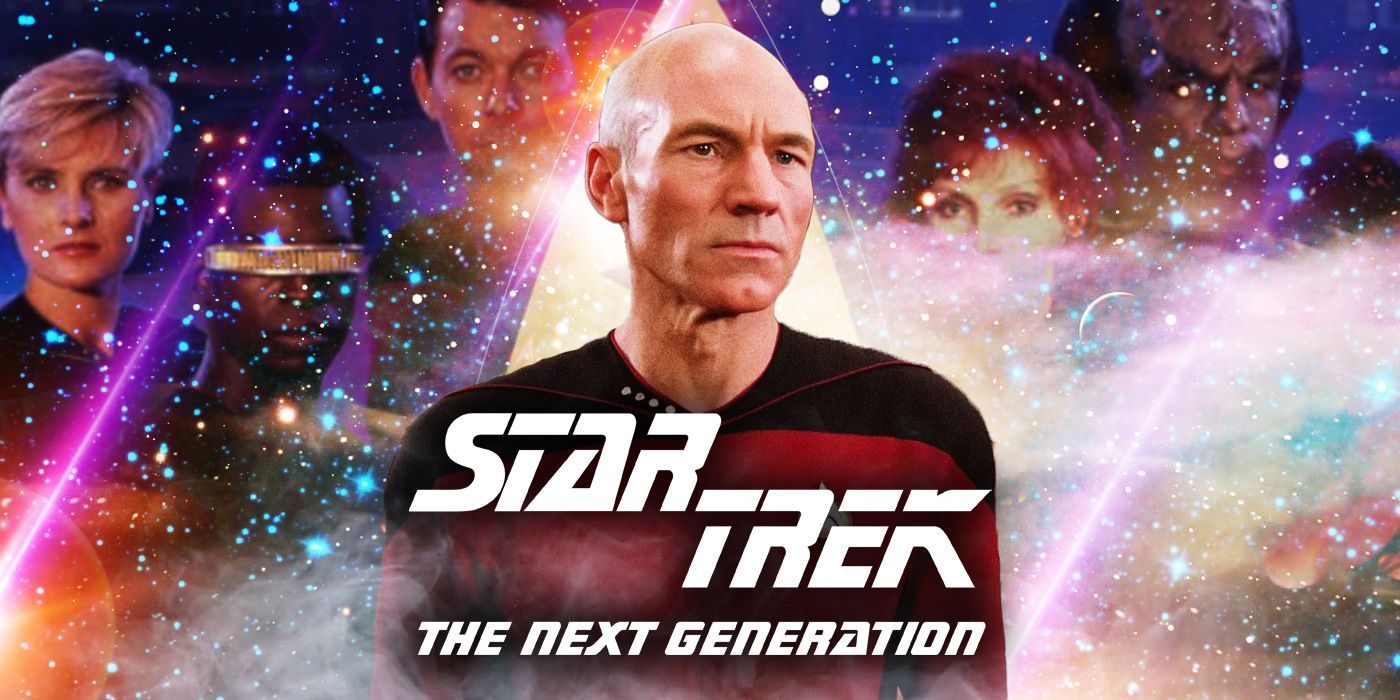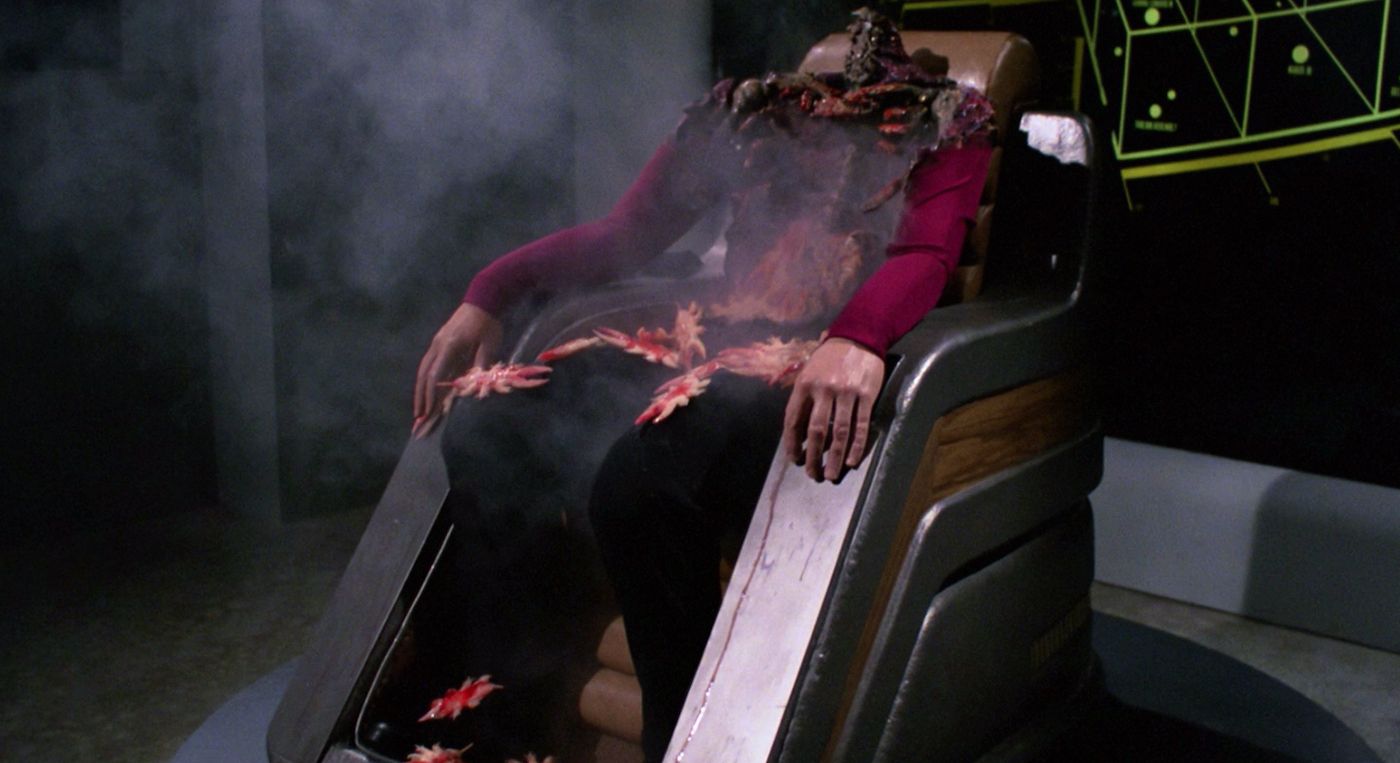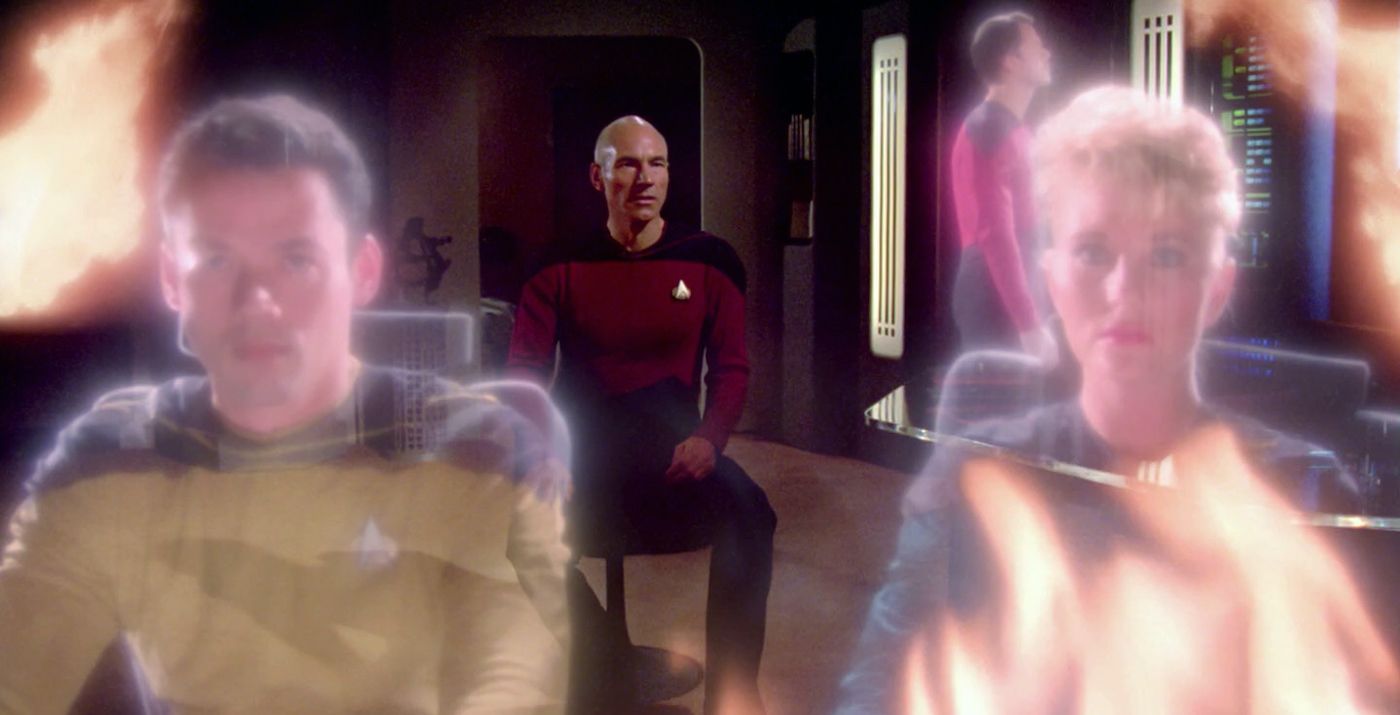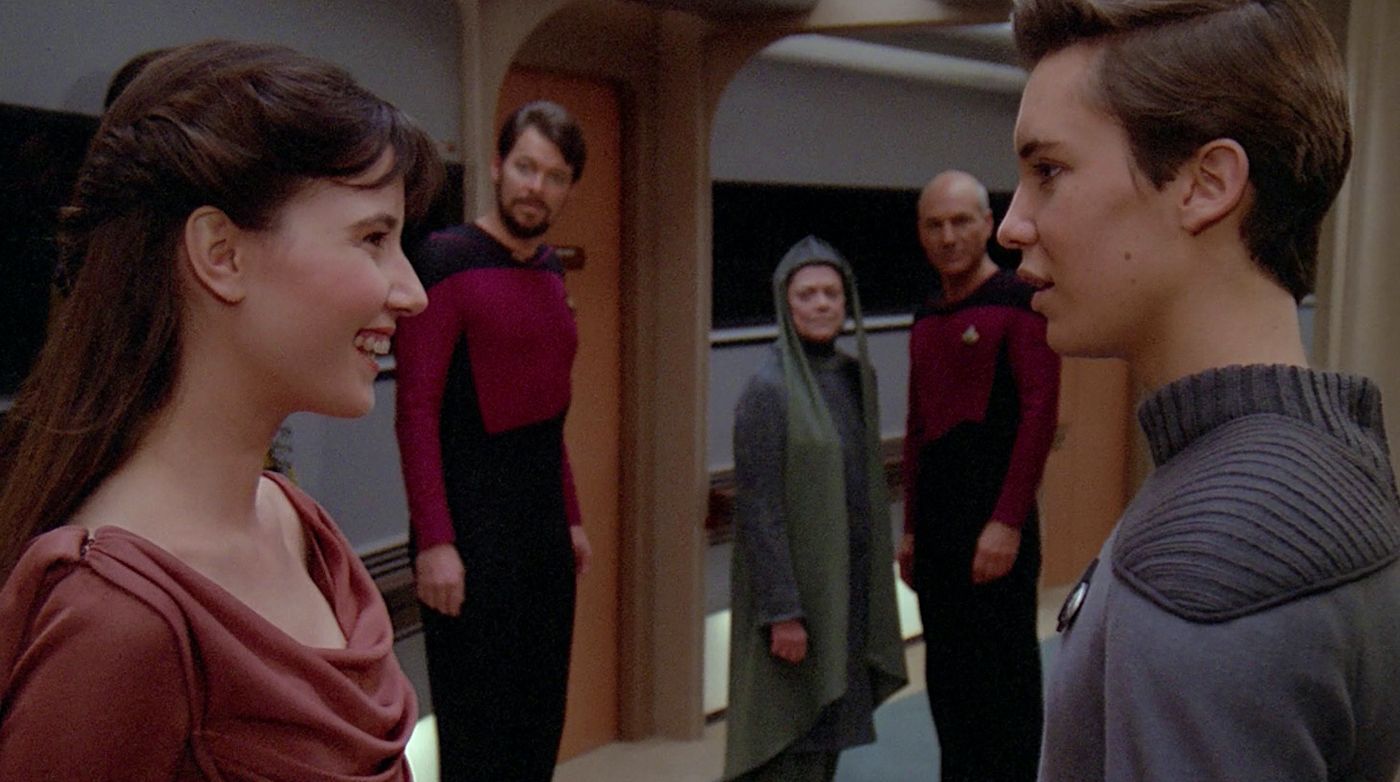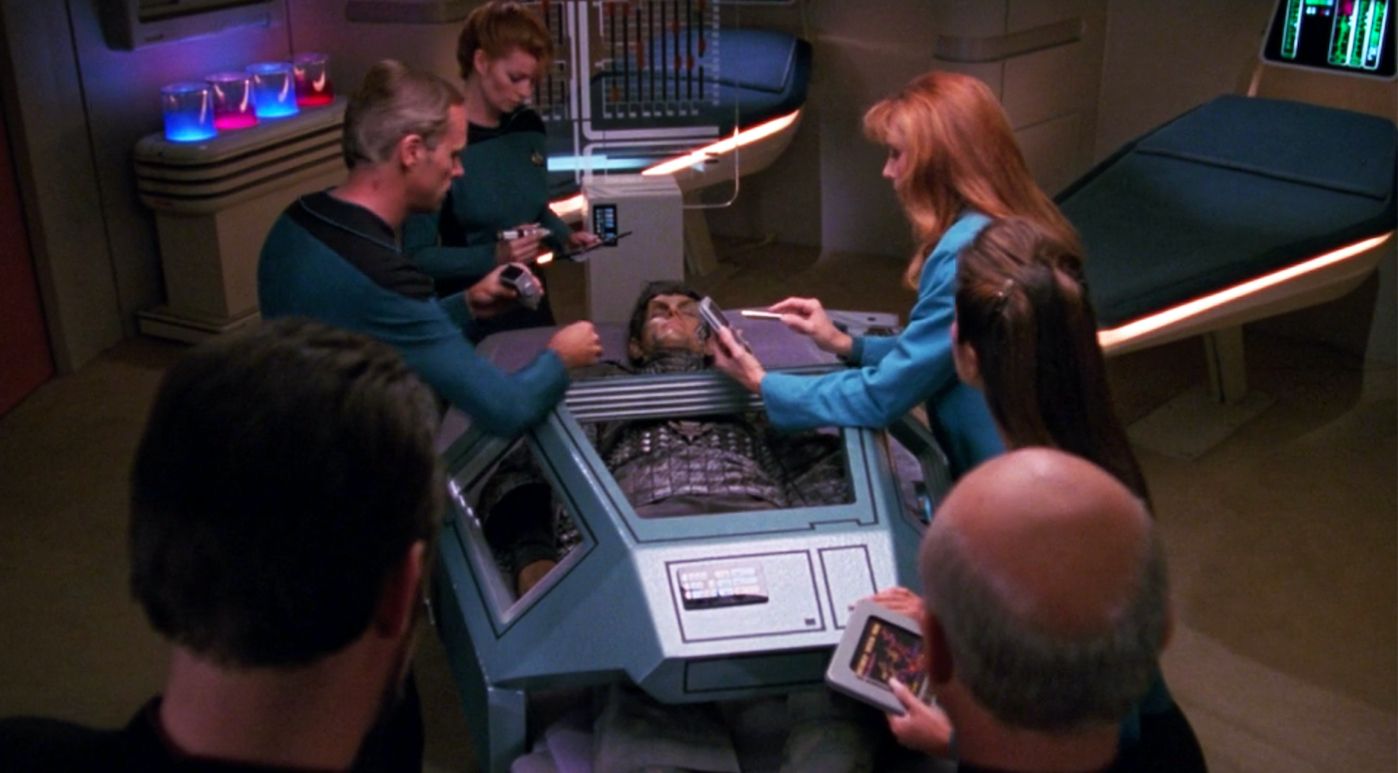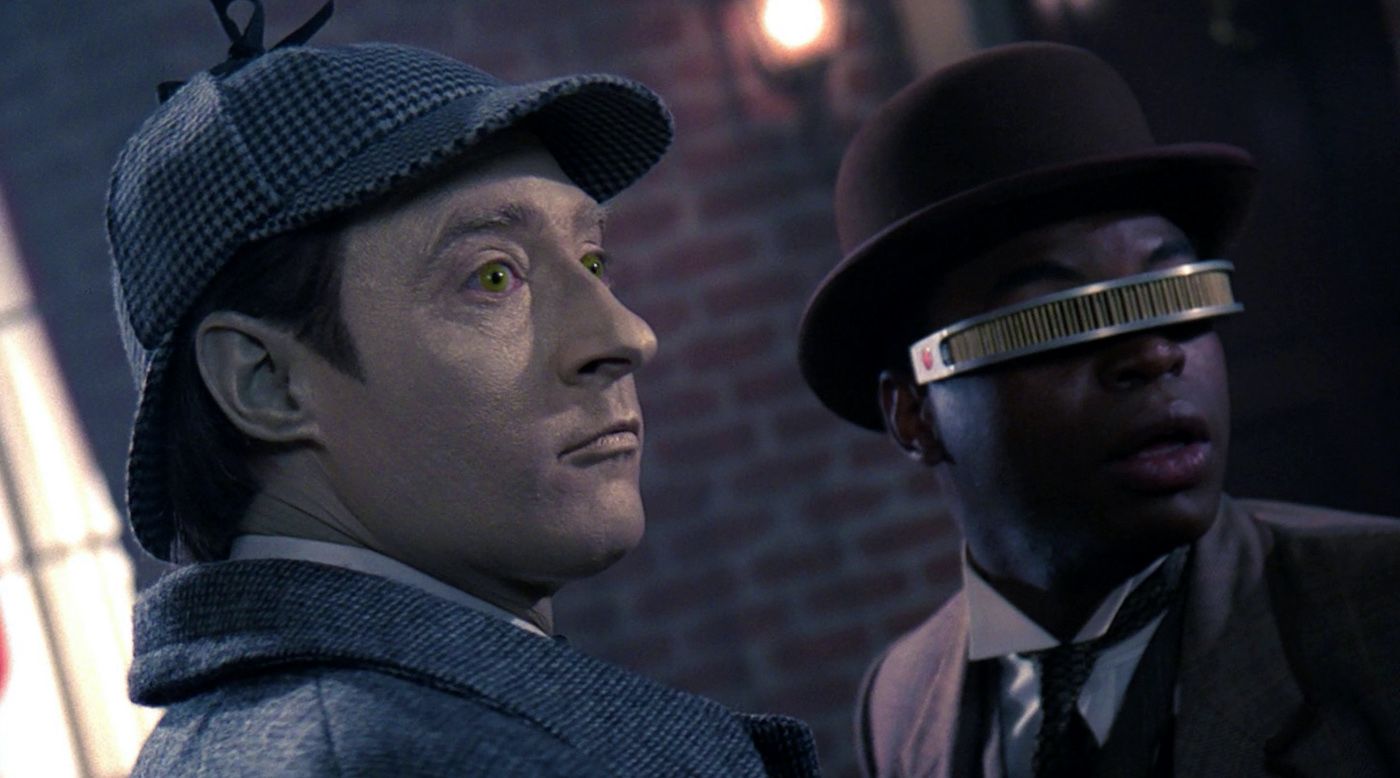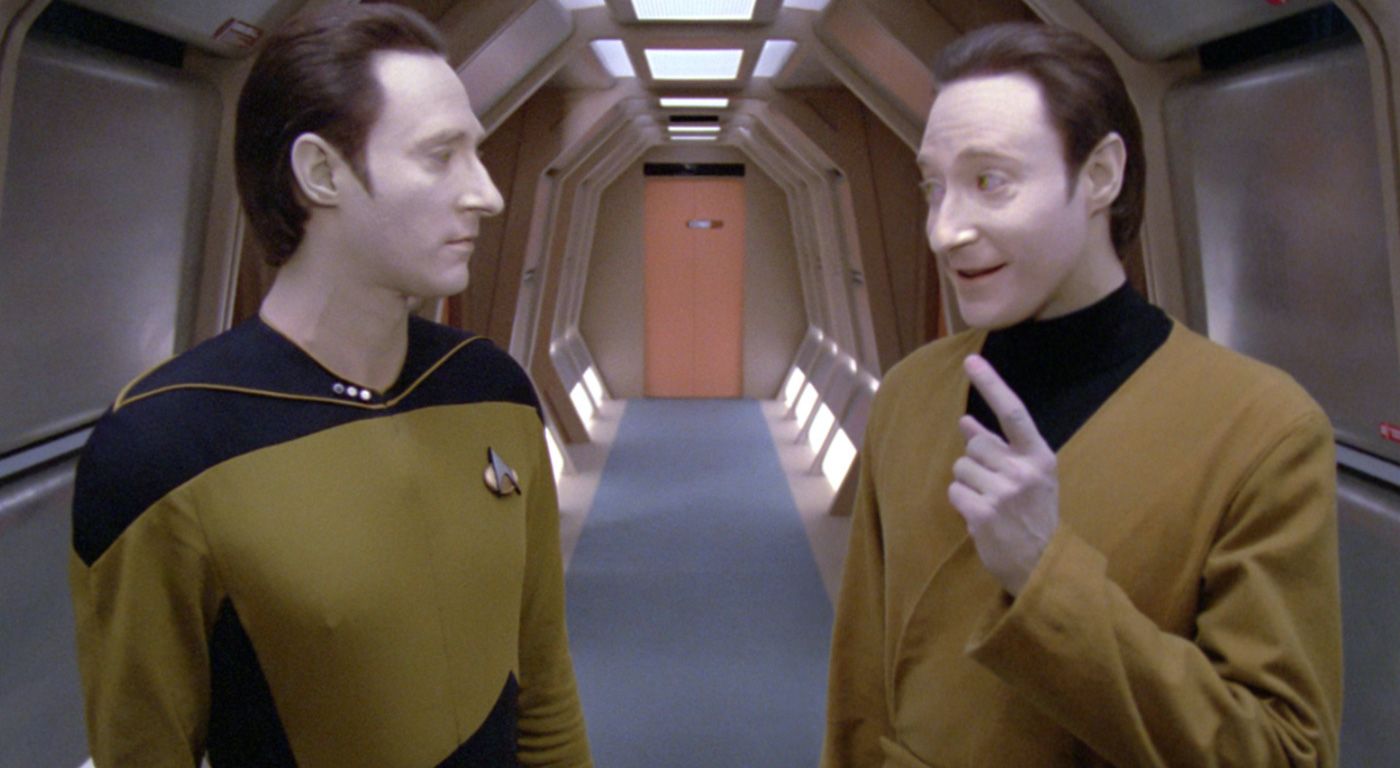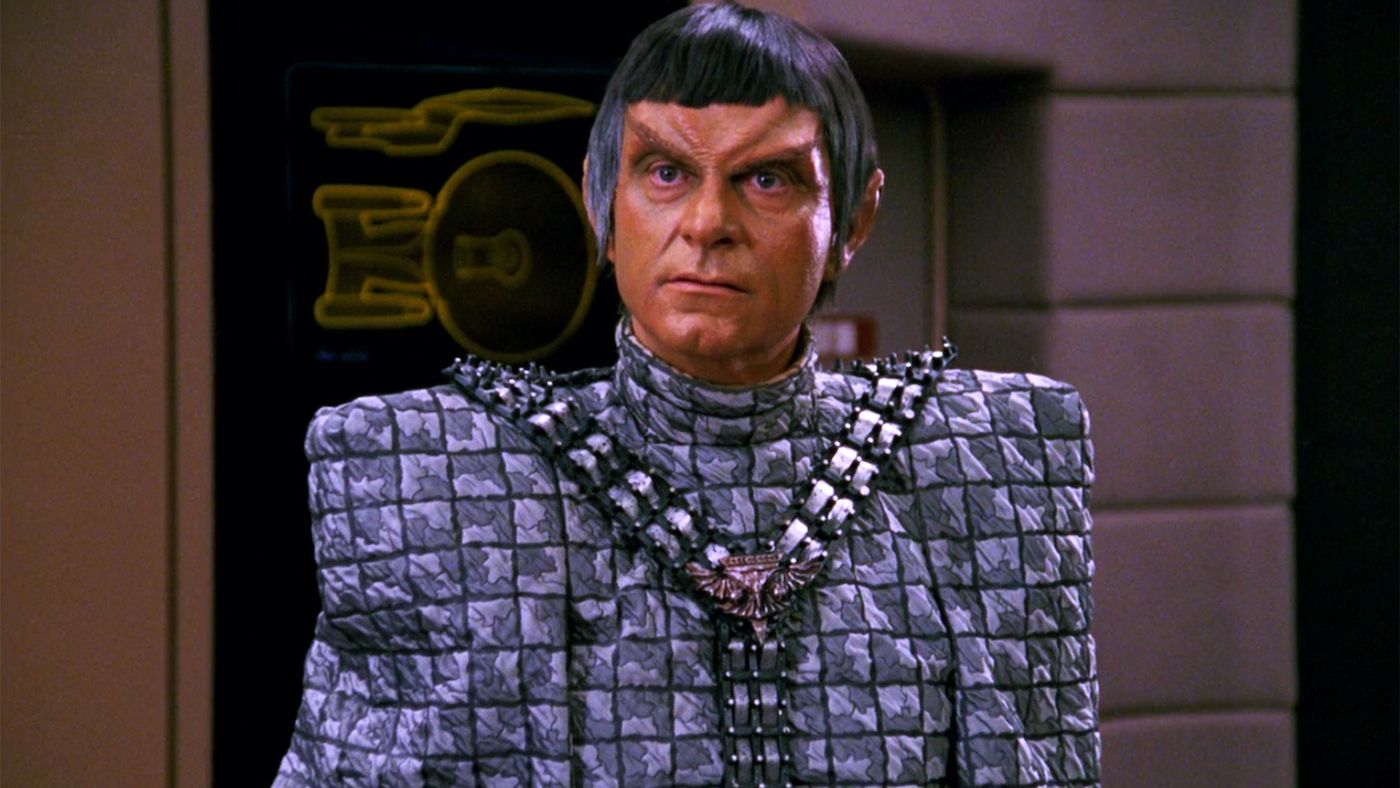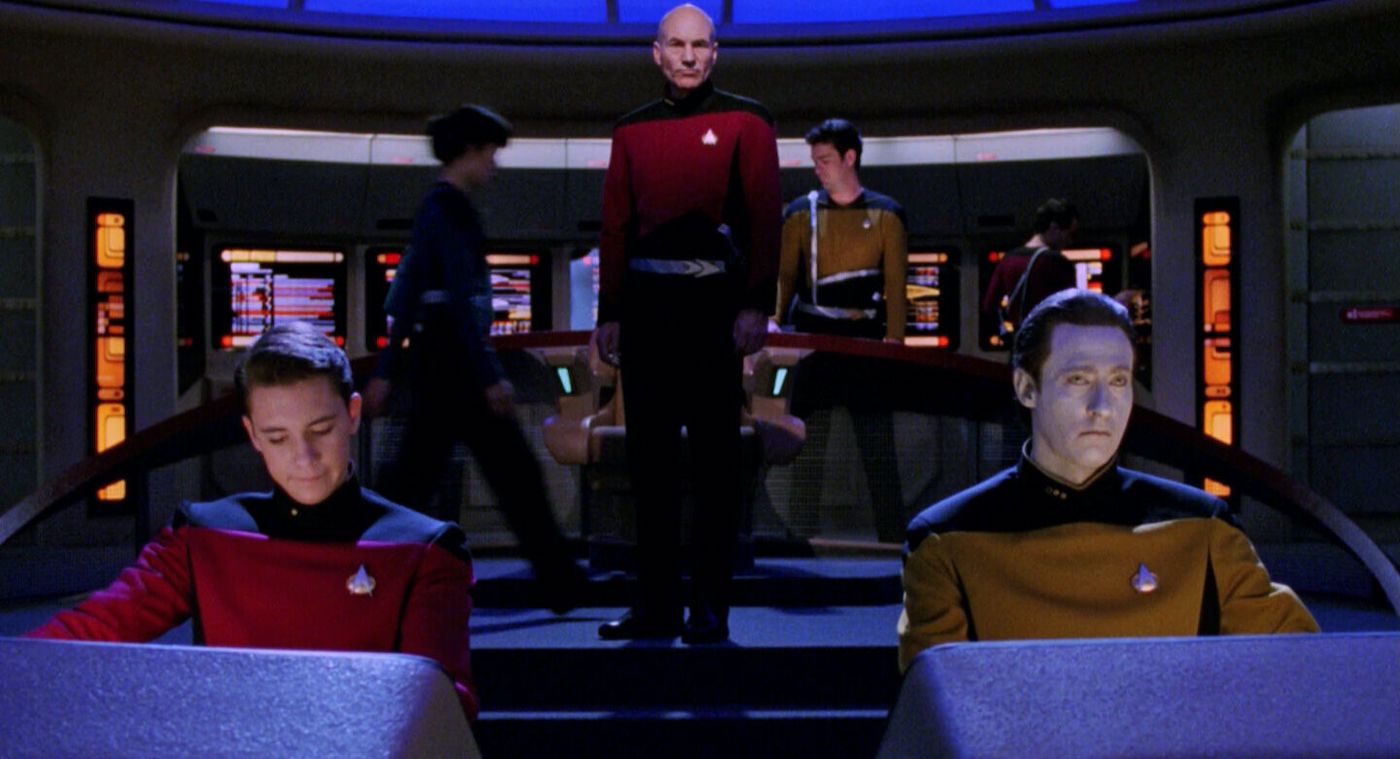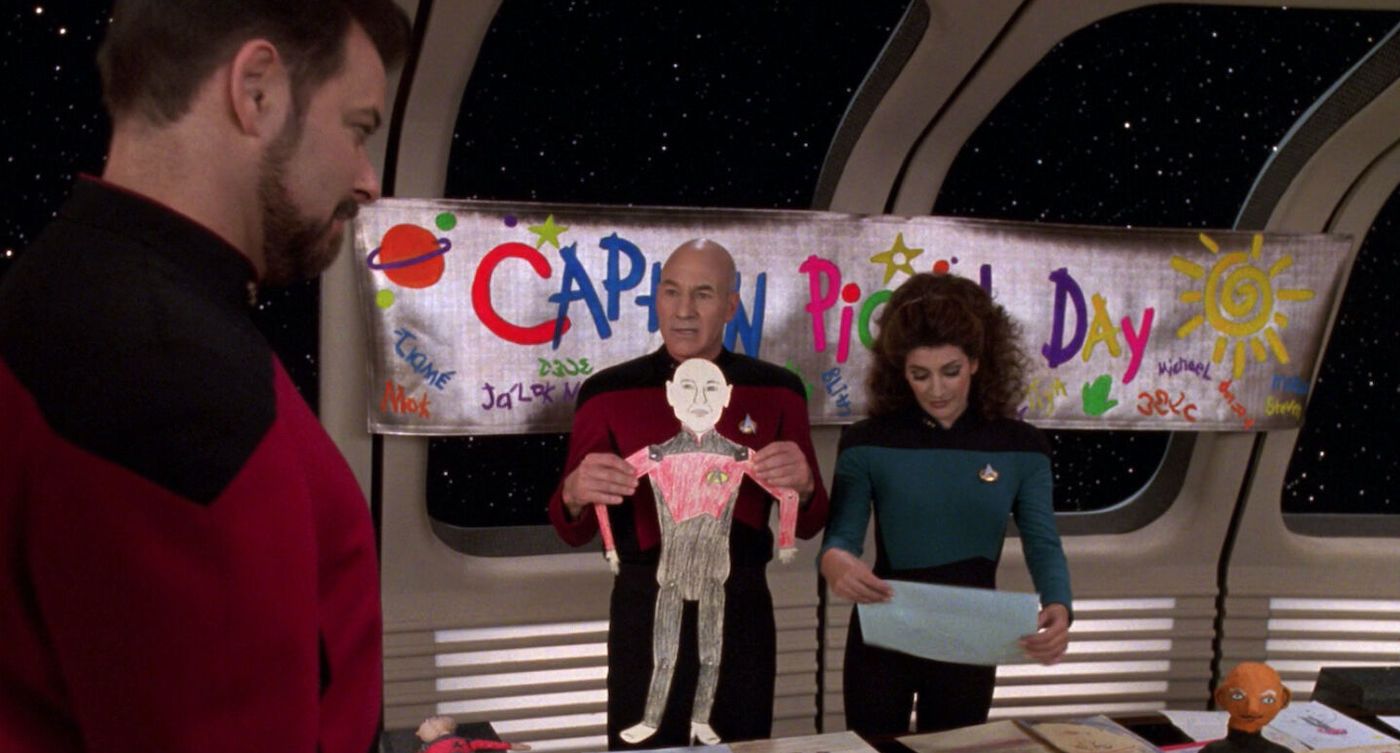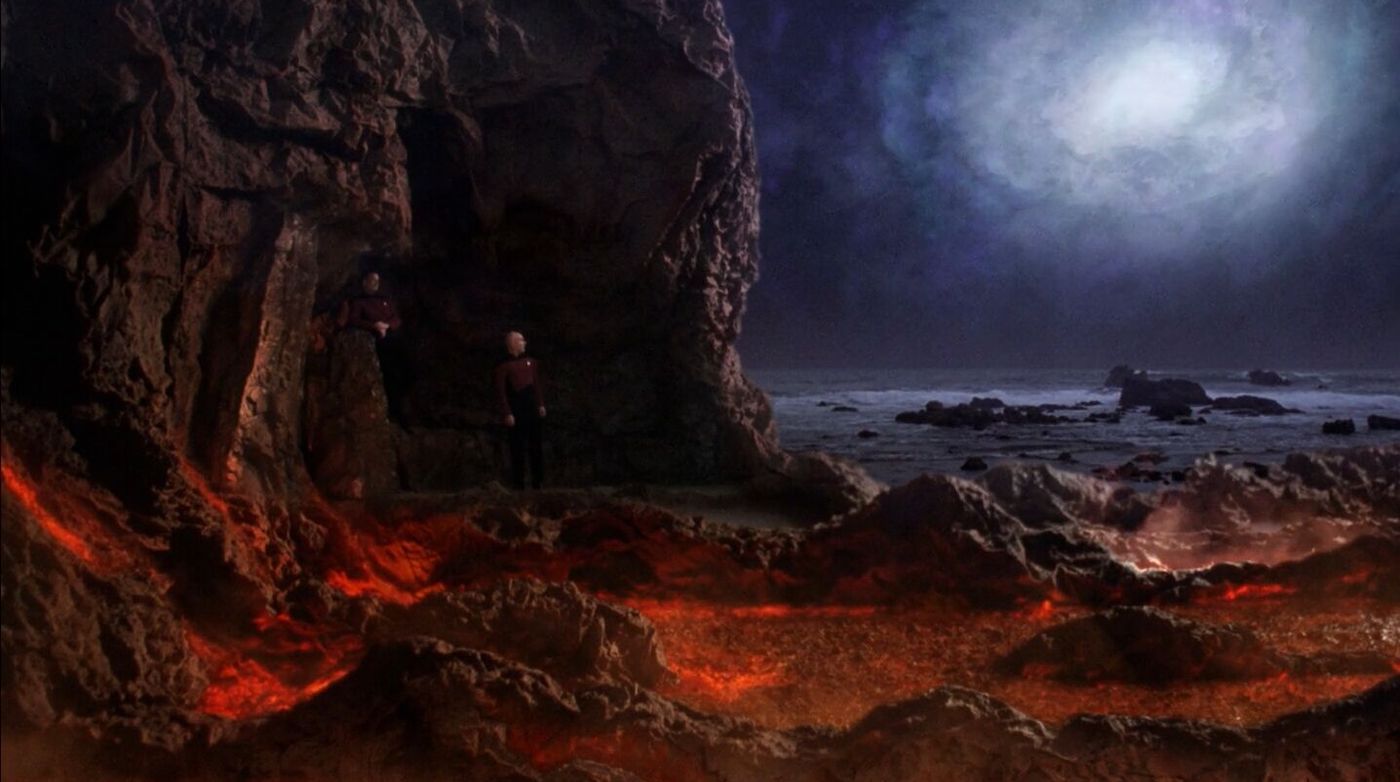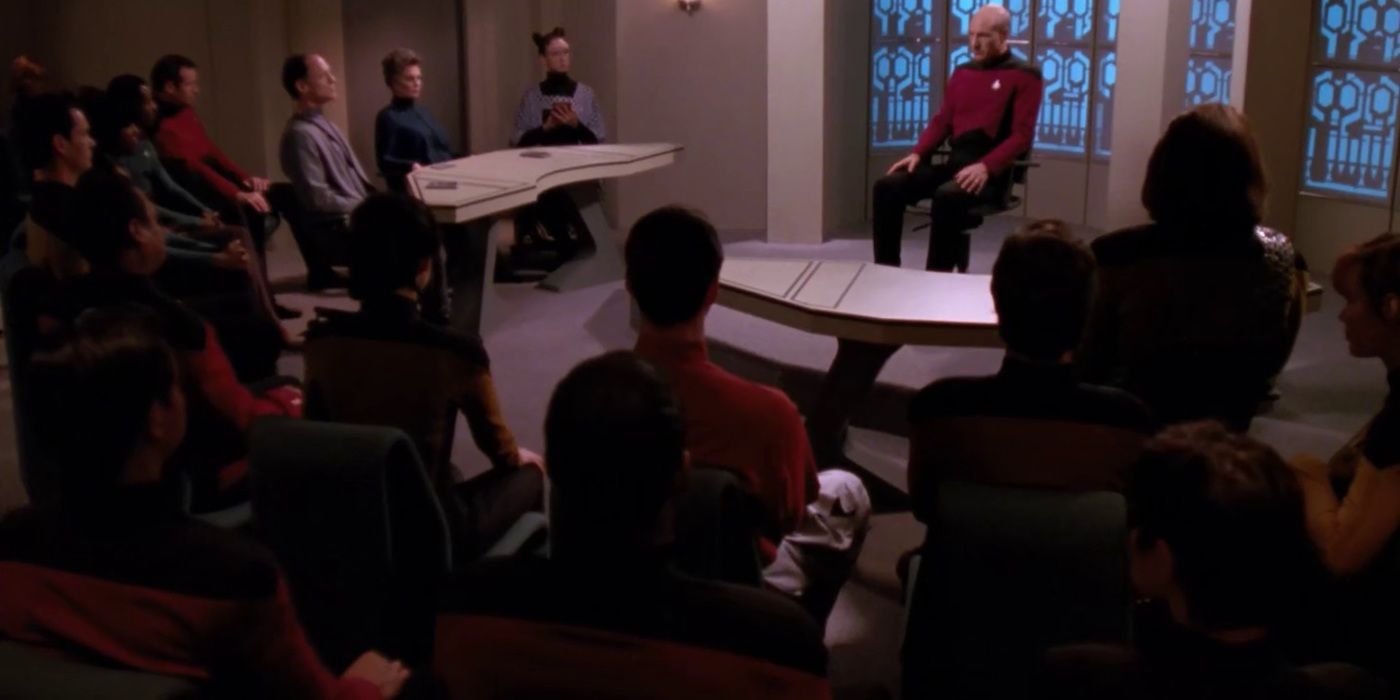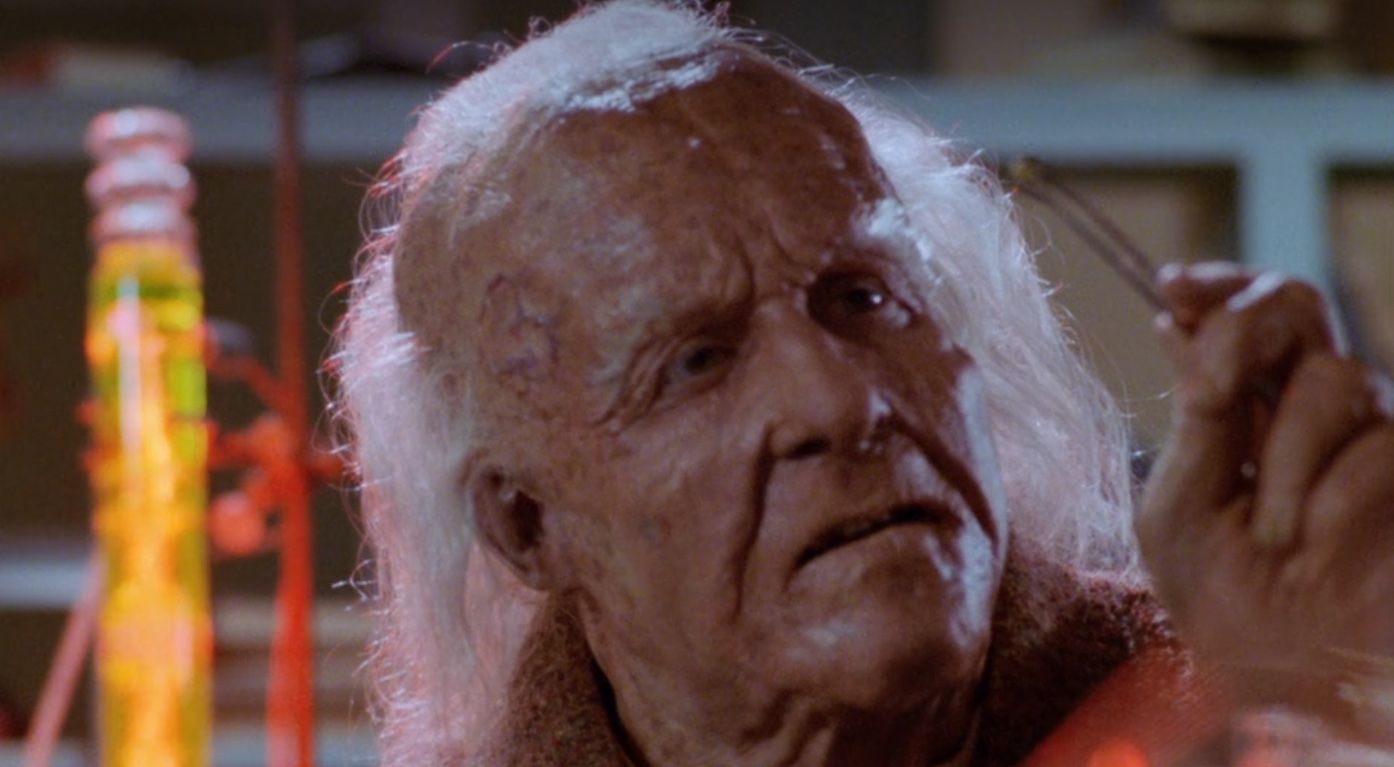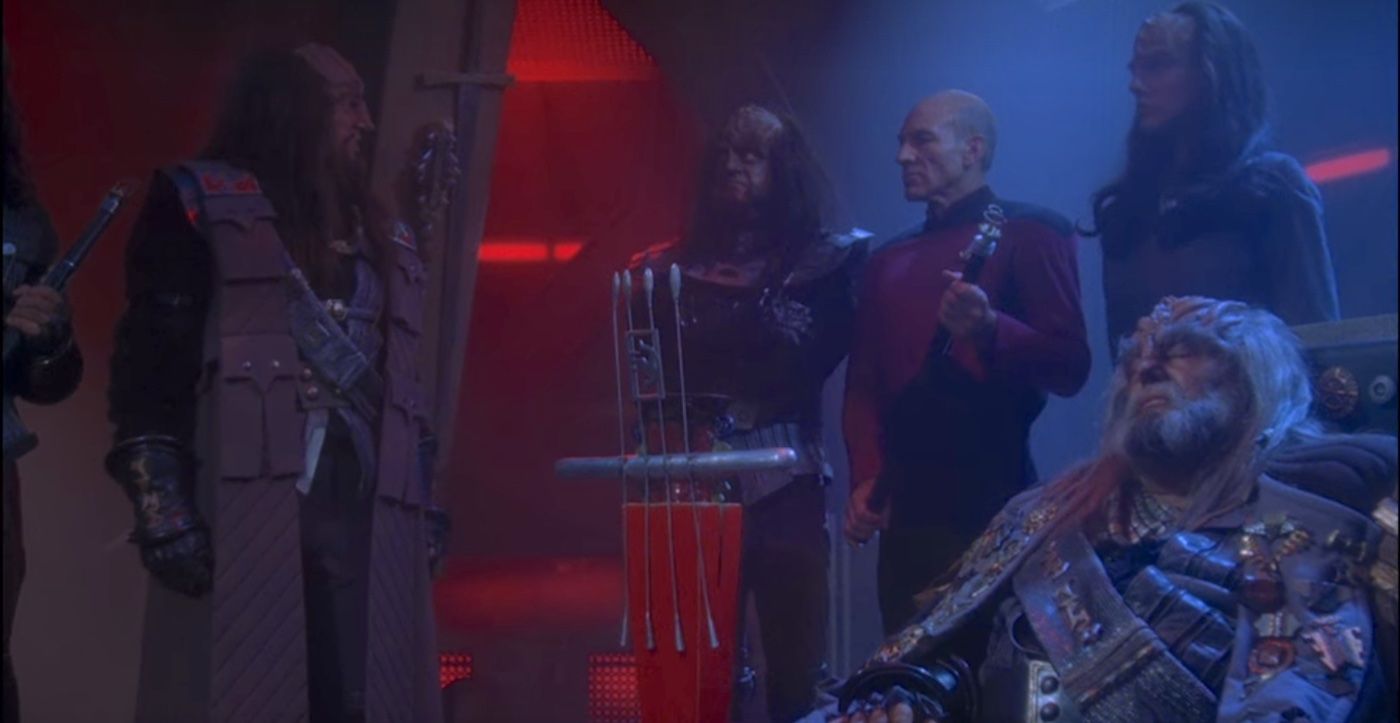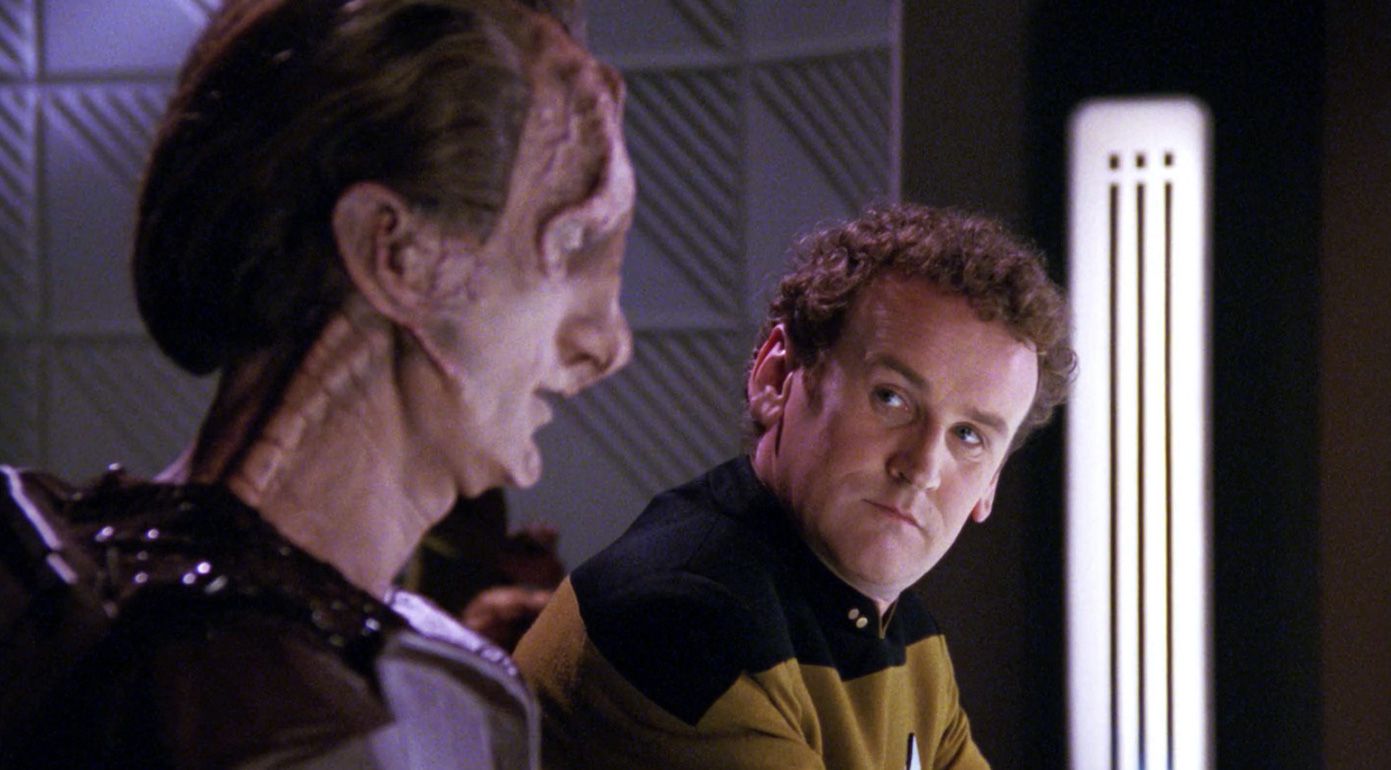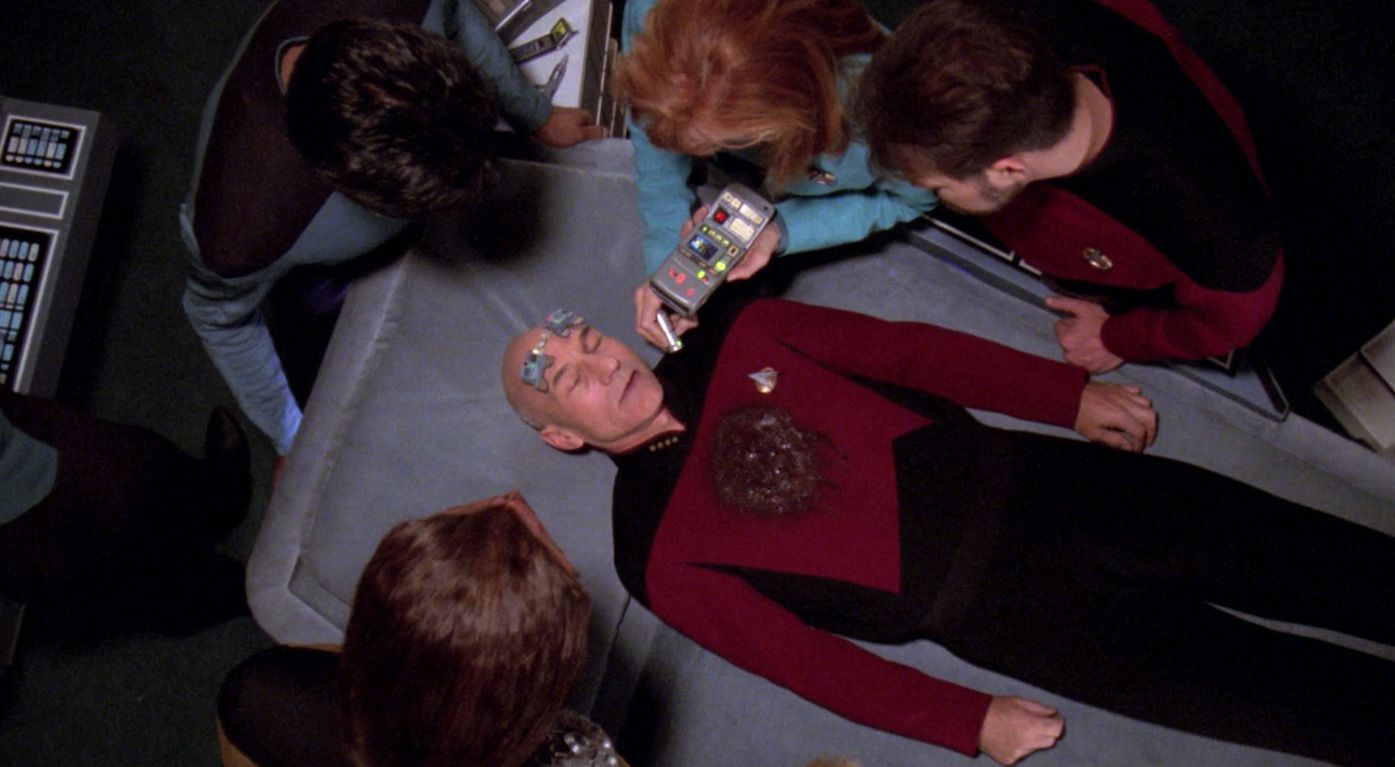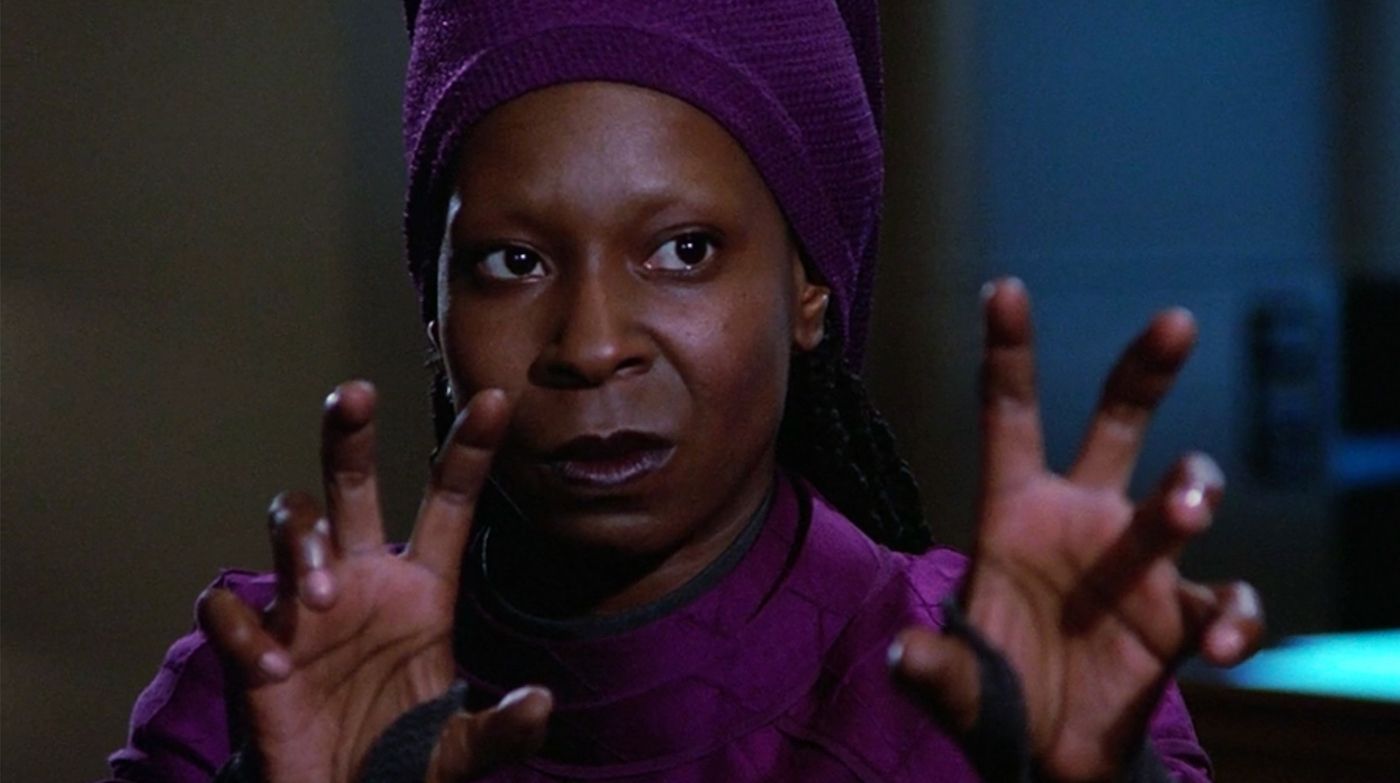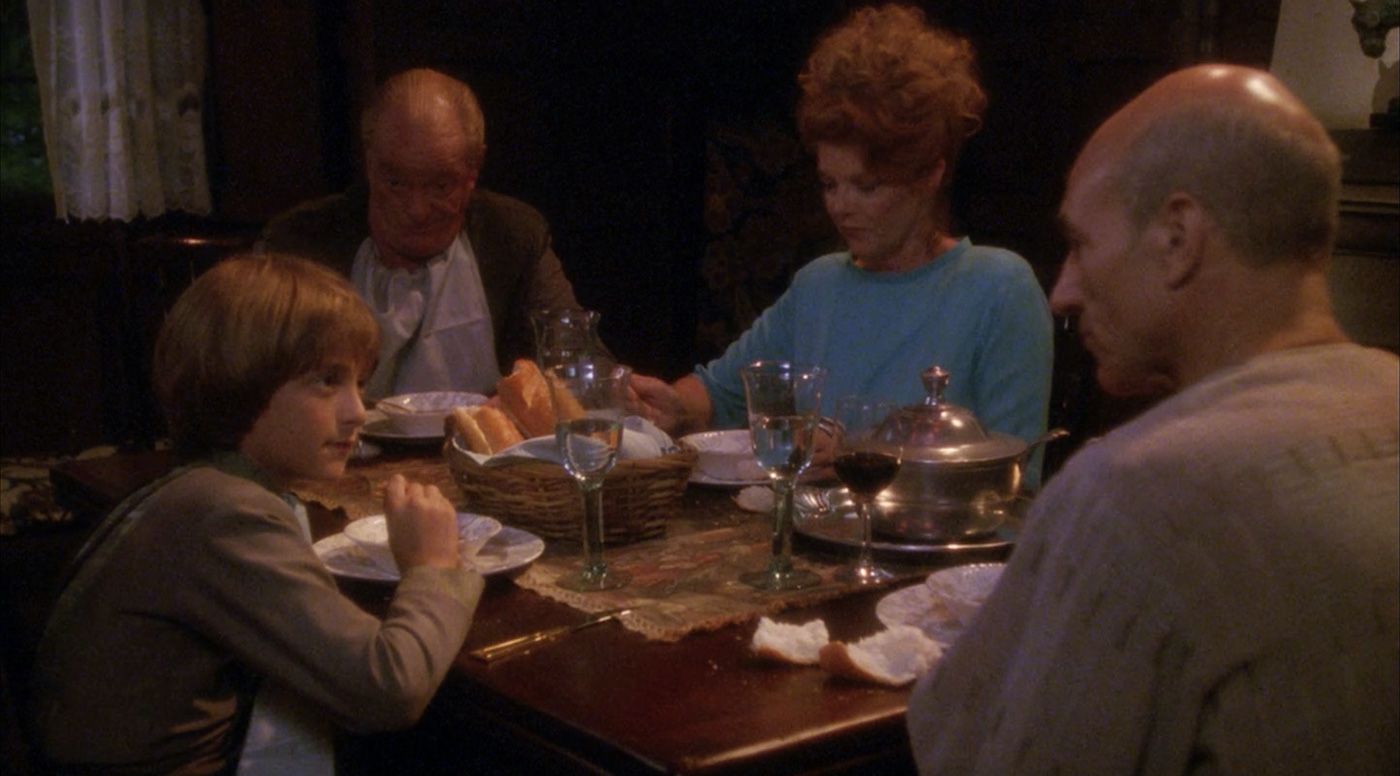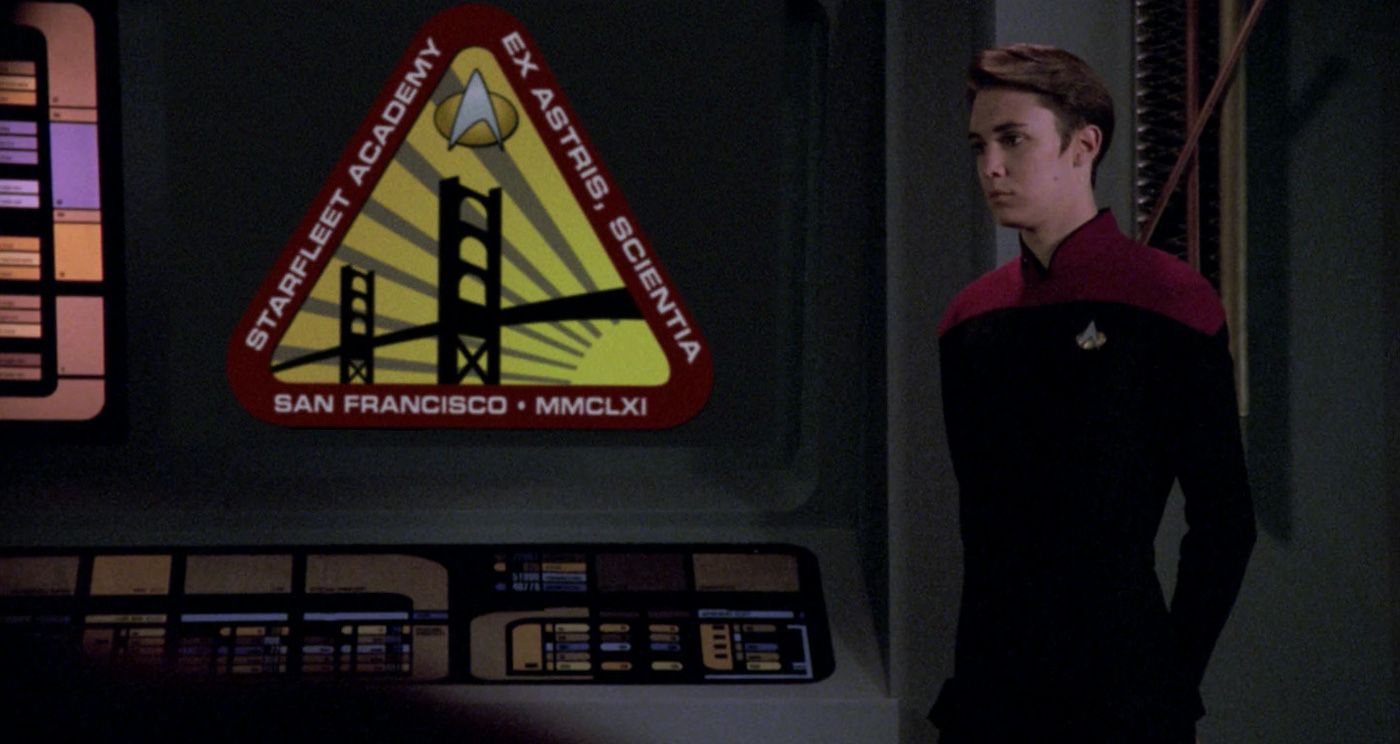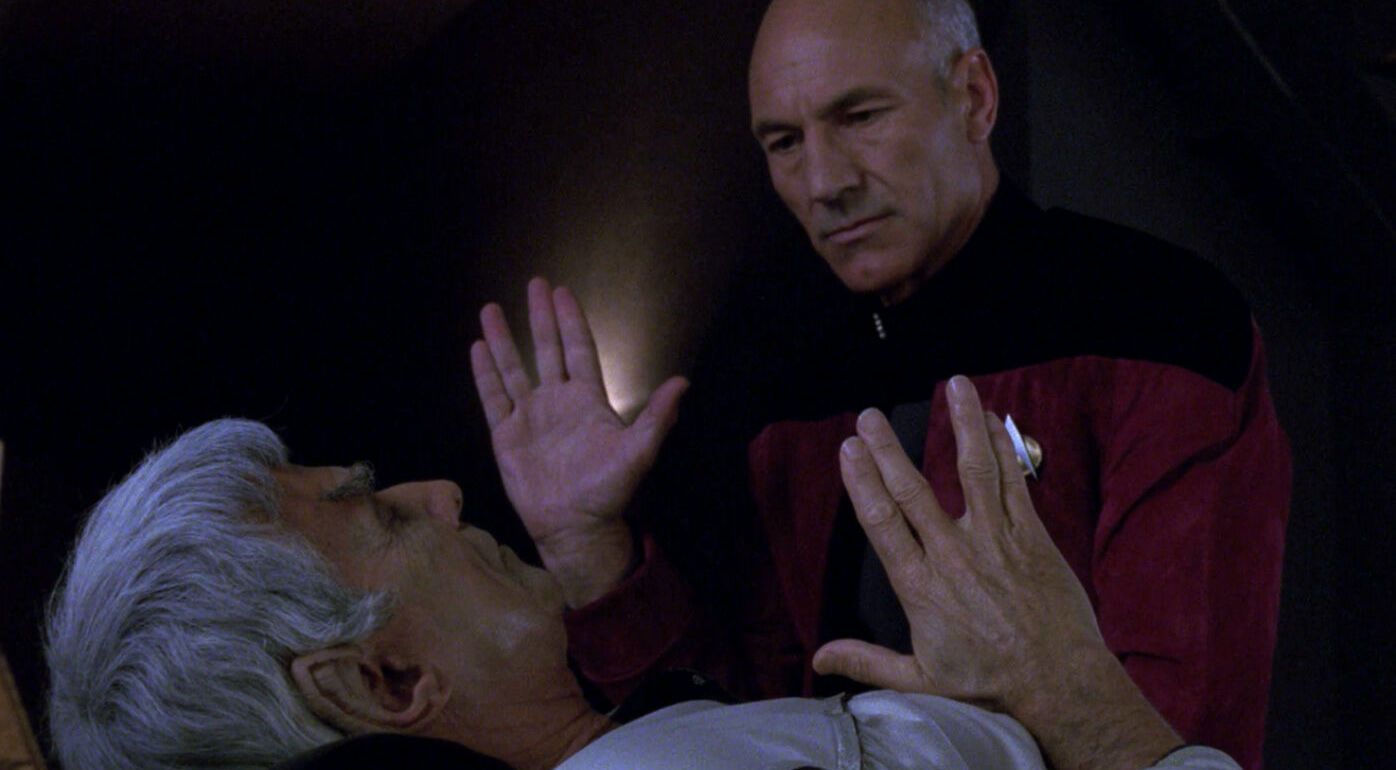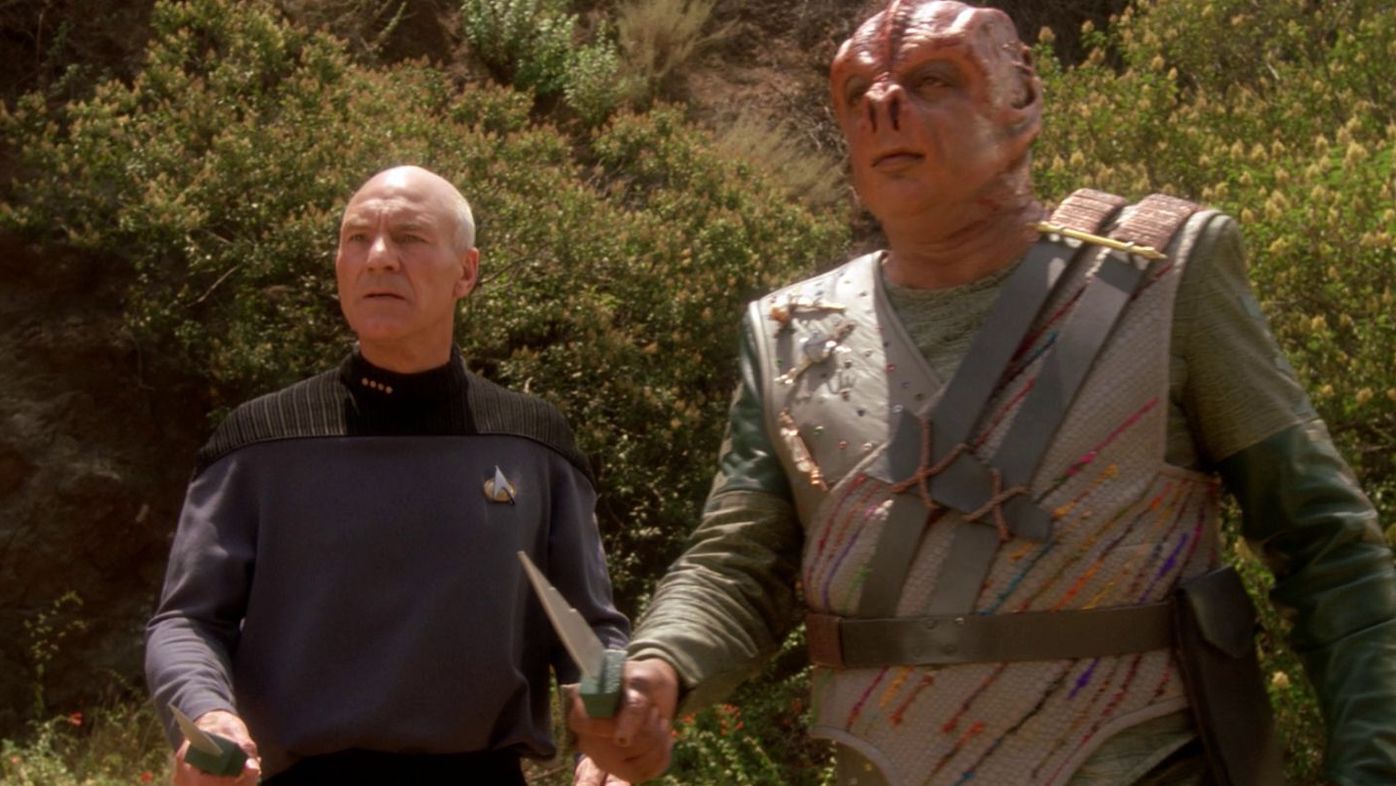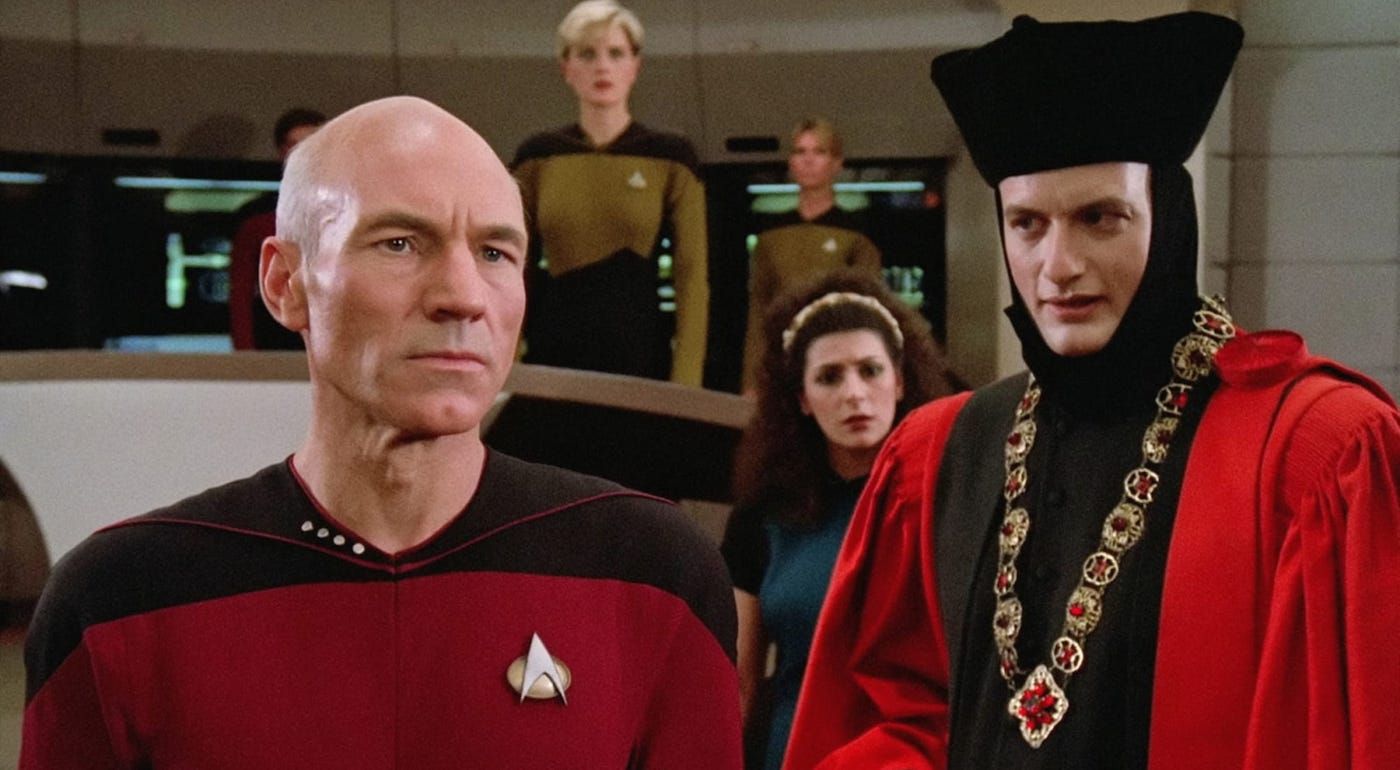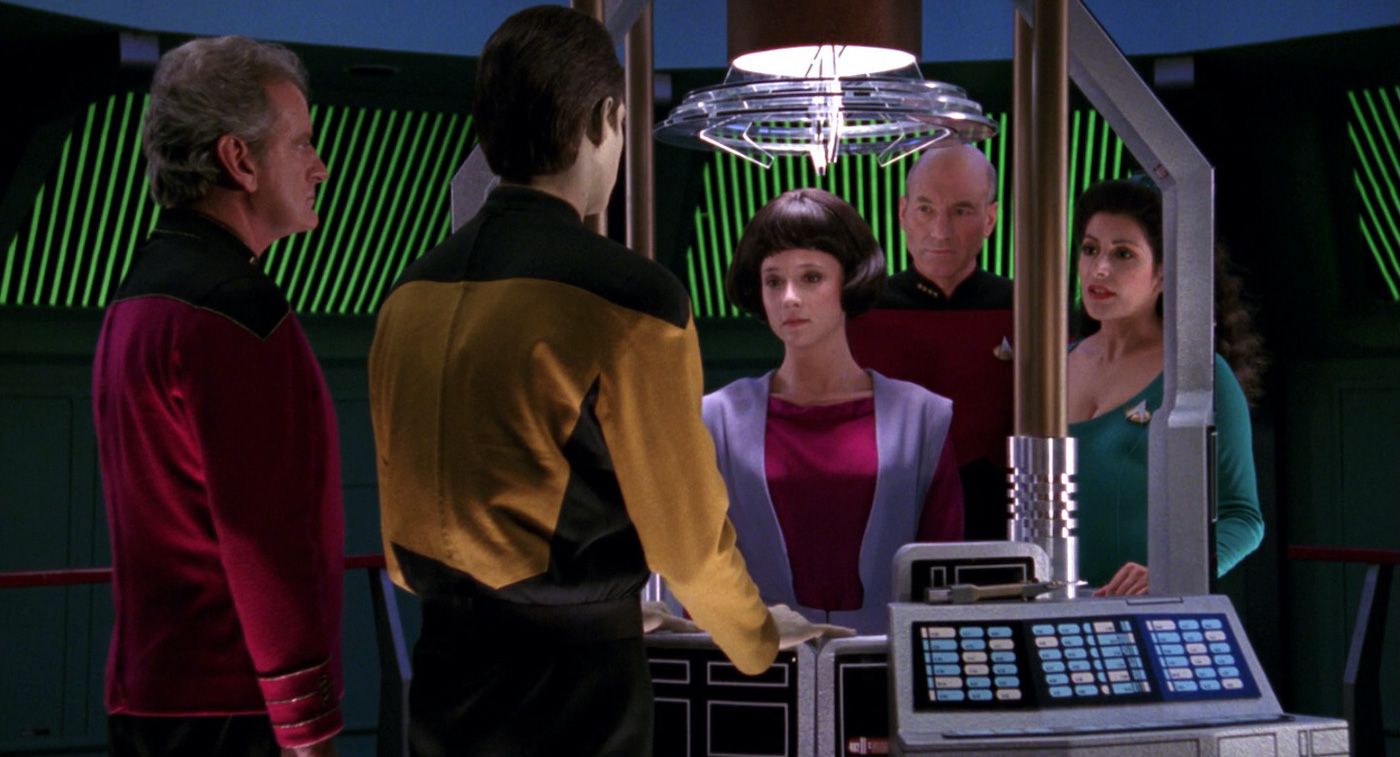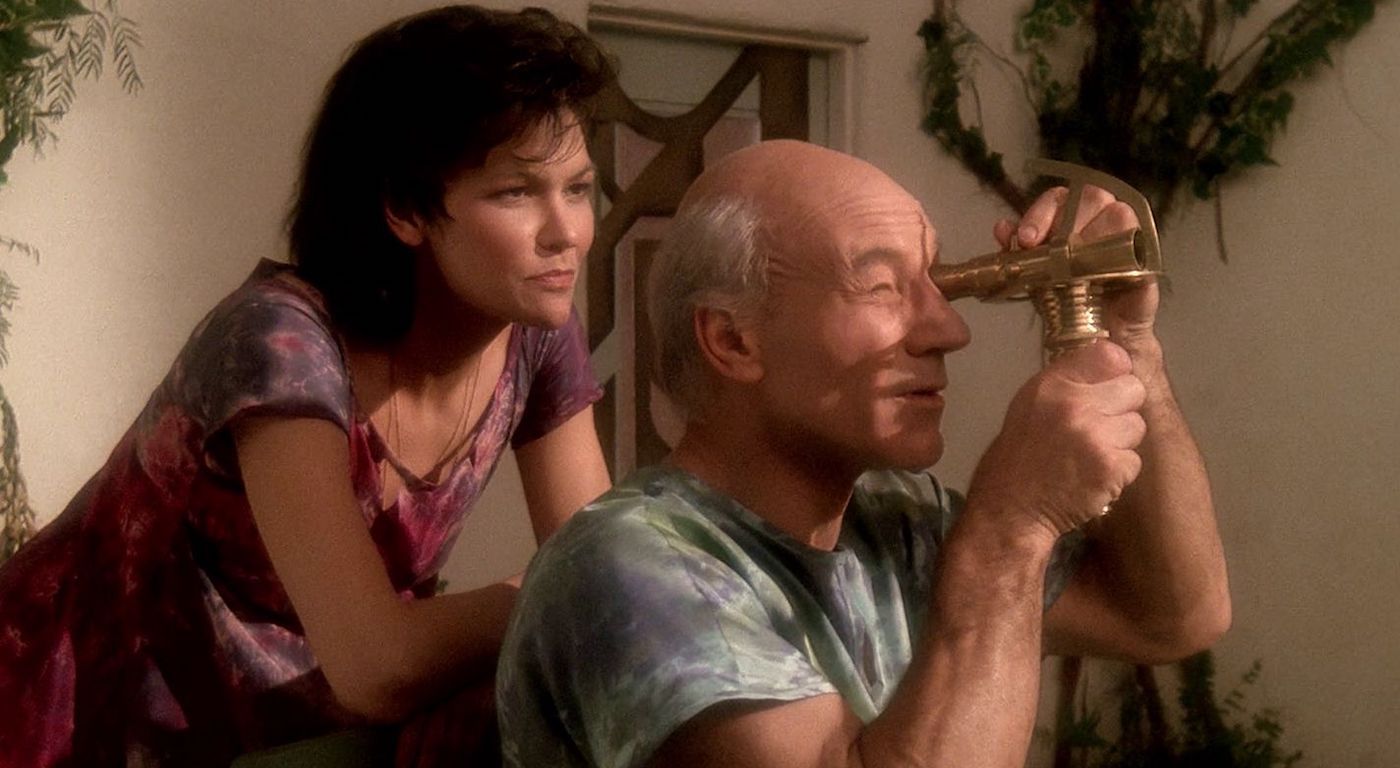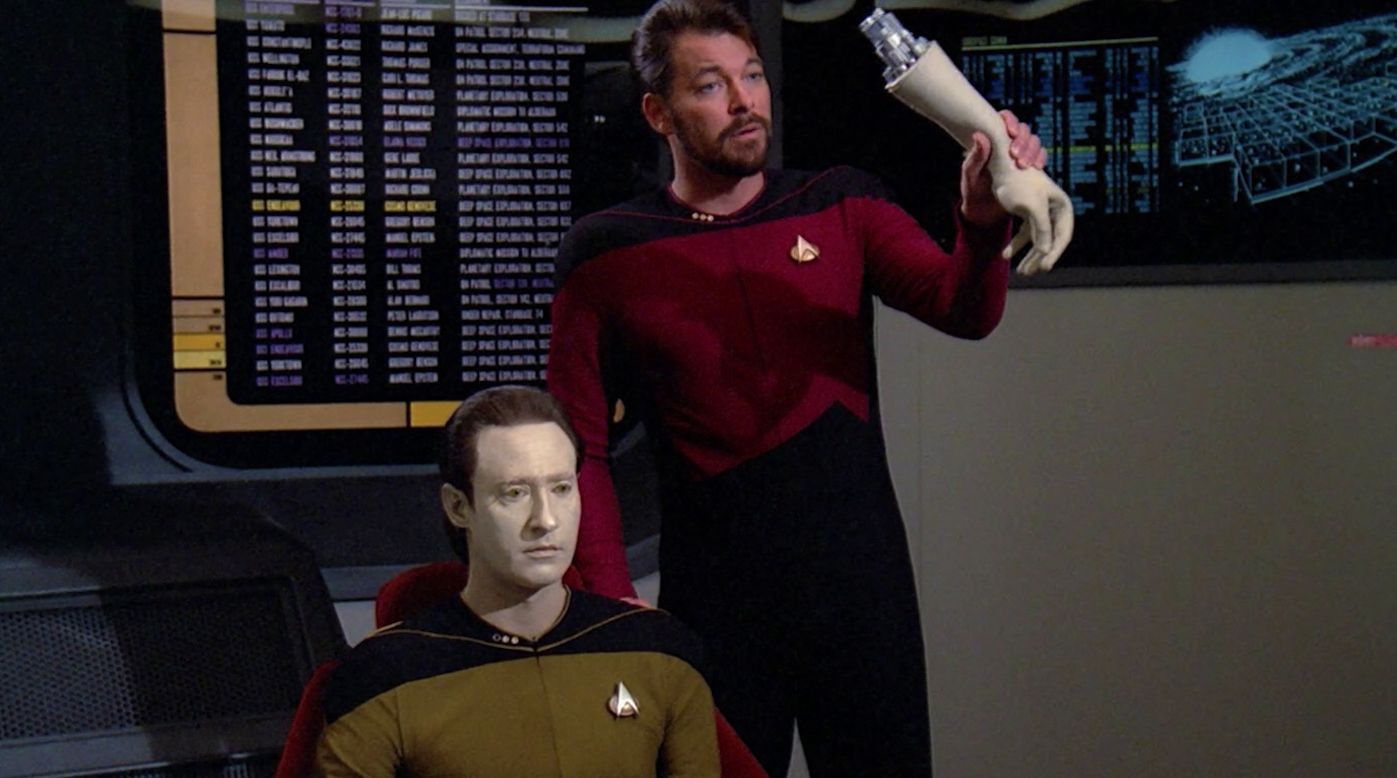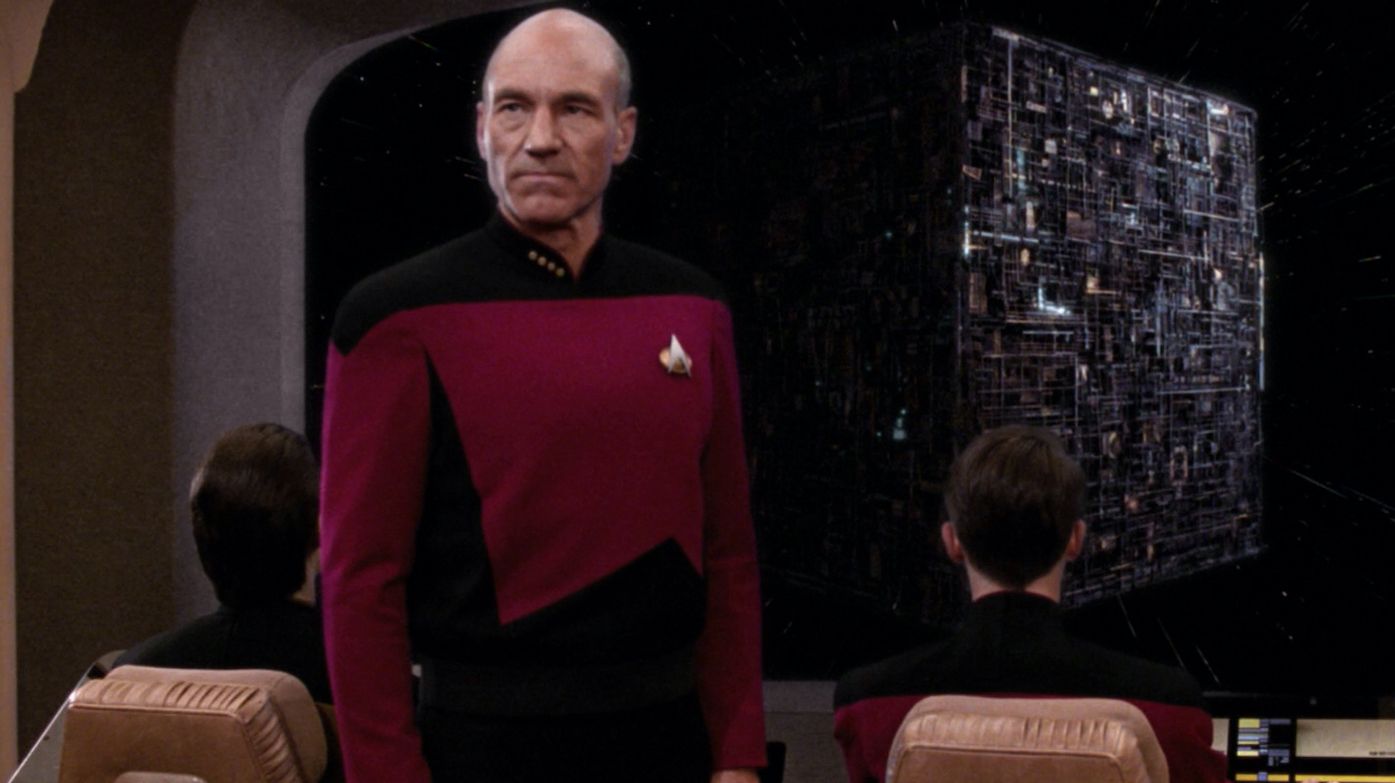The Star Trek TV universe is currently going strong, and none of it would be possible without Star Trek: The Next Generation. It was a risky follow-up to what, at the time, was a low-budget ‘60s sci-fi show with a cult following and successful film franchise. The Next Generation introduced us to an all-new USS Enterprise and a diverse crew, all set against a political backdrop that paralleled the post-Cold War world. It was a different time in television. By the time Star Trek’s creator, Gene Roddenberry, launched the second TV series in the franchise, it had been nearly twenty years since the show had been on the small screen (not counting the short-lived animated series voiced by the original cast). TNG’s first season drew strong initial ratings but they dipped considerably midway through its debut year. Given today’s attention spans and fierce competition driven by the ever-multiplying streaming outlets, few shows would be given the time and space TNG needed to find its voice. By the end of the first season, however, it was one of the most popular shows on TV.
If you somehow don’t know, Star Trek: The Next Generation follows the adventures of the USS Enterprise NCC 1701-D, some 80 years after the events of the original series. Captain Jean-Luc Picard (Patrick Stewart) leads with strength and compassion, with his brash and confident first officer, Commander Will Riker (Jonathan Frakes), Riker’s old flame and the ship’s Counselor, Deanna Troi (Marina Sirtis). Also joining them is Chief Medical Officer, Dr. Beverly Crusher (Gates McFadden), her son, Wesley Crusher (Wil Wheaton) and security chief Lt. Tasha Yar (Denise Crosby), a post later taken by Klingon officer Lt. Worf (Michael Dorn). To round it off, we also have android Operations Officer, Lt. Commander Data (Brent Spiner), and Chief Engineer Lt. Commander Geordi La Forge (LeVar Burton).
Here are the 25 best episodes of Star Trek: The Next Generation, ranked.
25. “Conspiracy” (Season 1, Episode 24)
To be honest, most of The Next Generation’s first season can be skipped over. It took time for the show to find its voice, and many episodes from Season 1 have not aged well at all. That said, “Conspiracy” is a pulpy sci-fi blast. Starfleet has been infiltrated and it’s up to the Enterprise to stop the parasitic body snatchers! The penultimate episode of Season 1 gives us some backstory on Picard and a much-needed look at Starfleet beyond the Enterprise. It’s also super weird and great fun, dealing with a long-gestating invasion by intelligent parasites which take over the host bodies. Remarkably, it deals with a massive conspiracy that is never mentioned again.
24. “The Battle” (Season 1, Episode 9)
Of the many memorable species TNG introduced into Trek lore, the Ferengi would become one of the most important. Their near-feral early incarnations are light years away from the hyper-capitalists we’ve come to know and love from Deep Space Nine. In “The Battle,” we meet DaiMon Bok (Frank Corsentino), who presents the captain’s old ship the USS Stargazer as a gift. Presumed destroyed years earlier in an encounter that took the life of Bok’s son, the Stargazer’s return rattles Picard. Bok manipulates Picard with a headache-inducing orb (as one does), and the captain relives the battle on the Stargazer’s bridge, thinking the Enterprise is his enemy. “The Battle” fills in a lot of Picard’s backstory, giving us a too-short glimpse into his life aboard his lost ship.
23. “The Dauphin” (Season 2, Episode 10)
Young acting ensign, Wesley Crusher, experiences his first pangs of love with a young girl who happens to be the only hope to end her home planet's long civil war and unite her people. The Enterprise escorts Salia (Jaime Hubbard), the heir to the leadership of Daled IV, and her overprotective guardian, Anya (acting veteran Paddi Edwards), to her homeworld after a lifetime spent studying in isolation. The standard first love plot is handled very well, with a bizarre mix of creatures thrown into the mix (Salia and Anya are shapeshifters). There’s also a cute scene where Riker and Guinan (Whoopi Goldberg) try to teach Wes how to flirt.
22. “The Enemy” (Season 3, Episode 7)
“The Enemy” finds La Forge stranded on an inhospitable planet with a Romulan after the Enterprise responds to a distress signal near the Neutral Zone. Meanwhile, Picard is locked in a standoff with a Romulan Warbird (bigger and theoretically more powerful than even the Enterprise) commanded by recurring baddie, Tomalak (Andreas Katsulas). La Forge and the Romulan must work together to survive, but we know that Romulans don’t like humans and are prejudiced against such disabilities as La Forge’s blindness. His VISOR technology ends up saving their lives, setting up a well-executed moral for the story. It’s always fun to watch Picard face down the Romulans with a mixture of sternness and diplomacy, and what could have been a treacly “message” episode ends on a satisfying note of hope for a future where both factions are not at each other's throats.
21. “Elementary, Dear Data” (Season 2, Episode 7)
The Holodeck is one of TNG’s key additions to the annals of Trek, opening up endless story possibilities. It has been included in some form or another in the spin-off shows taking place during or after the TNG timeline. Here, Data and La Forge cosplay as Sherlock Holmes and Dr. Watson. Brent Spiner gets to show off his range: as Data, he would go on to play various hambone Wild West stereotypes, Prospero from Shakespeare’s The Tempest, Data’s brother Lore, Data’s father Noonien Soong, and more.
Since Data already knows all the mysteries, what’s left to do? La Forge instructs the computer to create a character capable of defeating Data, accidentally creating a sentient version of Sherlock’s arch-nemesis, Professor Moriarty (Daniel Davis), who manages to take control of the ship itself. There have been countless other sentient-AI narratives across the sci-fi landscape in general, and a great many within the Trek universe. Few, if any, are this playful and clever.
20. “Datalore” (Season 1, Episode 12)
The “evil twin” trope was a strange thing to drop into a sci-fi series, but the introduction of Data’s brother, Lore, showed audiences just how versatile an actor Brent Spiner could be. The Enterprise investigates Omicron Theta, the planet where Starfleet officers first found Data and activated him. They find another disassembled android identical to Data, who calls himself Lore. Created before Data by Noonien Soong and given a full range of emotions, Lore is manipulative and untrustworthy and tries to offer up the Enterprise crew to the creature known as the Crystalline Entity. “Datalore” begins an interesting arc for Data with Lore’s introduction, giving him an “evil” counterpart. Data as an “unfinished” being is an important theme that TNG will revisit again and again.
19. “The Defector” (Season 3, Episode 10)
A high-ranking Romulan defects to the Federation but Picard and company have to decide whether or not to trust him. This episode is one of the better attempts to explore the morally gray area between the Federation and their traditional antagonists, the Romulans. The two sides have been locked in a cold war for apparently decades, but the Romulans can be seriously nasty. The defector, played by veteran character actor and frequent Trek guest star, James Sloyan, poses as a low-level lieutenant but is eventually revealed to be an admiral named Jarok.
During the war between the Romulans and the Federation, Jarok was responsible for brutal attacks on Federation outposts. He risks his life and career — not to mention probably never seeing his family again — to try and prevent another war. His information turns out to be bait to lure the Enterprise into the Neutral Zone, justifying an attack. Jarok is crushed, and Sloyan’s soulful performance makes this one of the most memorable episodes from the show’s overall excellent third season.
18. “Yesterday’s Enterprise” (Season 3, Episode 15)
Since the second season of Star Trek: Picard will thrust the crew of the La Sirena into some kind of alternate dimension thanks to Q, it’s worth taking a look at the one and only time the crew of the Enterprise-D took a trip into something resembling a Mirror Universe. Encountering a rift in spacetime (there appear to be a lot of these floating through the galaxy), the previous ship named Enterprise, NCC-1701-C, floats through after taking heavy fire while defending a Klingon outpost from a Romulan attack. In the main timeline, the Enterprise-C was destroyed and this sacrifice earned the Klingon Empire’s respect. When it came through to meet the Enterprise-D, everything changed.
The Enterprise-D is now a ship of war, the Federation and the Klingons have been at each other's throats for decades, Denise Crosby is back as Lt. Tasha Yar, and even the lighting is moodier. Guinan’s never-fully-explained sixth sense allows her to remain the only person to notice the change. “Yesterday’s Enterprise” is one of the better time-travel entries and sets up some clever ways to bring the much-missed Crosby back into the fold in later episodes.
17. “The Pegasus” (Season 7, Episode 12)
Infamous among TNG fans for the role that “The Pegasus” plays in the bizarre series finale of Star Trek: Enterprise, one of the standout episodes of the final season sees Riker confronting some genuinely traumatic secrets from his past. The Enterprise escorts Starfleet Intelligence honcho, Admiral Pressman (Lost star Terry O’Quinn) on a sensitive mission. Pressman can’t let the troubled Picard know anything beyond their destination (the edge of the Romulan Neutral Zone) and their target: Pressman’s lost ship the USS Pegasus. A stunned Riker clearly knows more than he lets on, as the Pegasus was his first posting as a young ensign. “The Pegasus” shows us a rare conflicted and vulnerable Riker. Number One is on shaky ground with Picard after dodging questions about what happened to the long-lost Pegasus amid reports of an unthinkable mutiny.
16. Season 7, Episodes 25 & 26: (Series Finale): “All Good Things…”
The seventh and final season of The Next Generation features some very strong episodes and a cast that had fully grown into their characters. The TNG series finale served as a neat bookend for the pilot, as John DeLancie’s always-welcome Q shows up again to continue the trial from Picard and the Enterprise-D’s inaugural mission. This time, Picard becomes unstuck in time, jumping between 25 years in the future, the present, and the past during the pilot’s Farpoint mission. Q forces Picard into a nonlinear puzzle, as a spatial anomaly that grows bigger the further back in time it goes threatens to prevent the formation of life on Earth. A fine cap on seven years of worldbuilding, “All Good Things…” explores the cause and effect of paradoxes, offering a possible glimpse of the crew’s future long before Star Trek: Picard’s canonical return to this universe.
15. Season 4, Episode 21: “The Drumhead”
An explosion in the Enterprise’s dilithium chamber is thought to be the result of sabotage, luring famed Admiral Norah Satie (Hollywood legend Jean Simmons) out of retirement to lead an investigation. “The Drumhead” edges into legal thriller territory as Satie — the daughter of a famous judge — turns the proceedings into an inquisition. While the judge discovers that a Klingon exchange officer has been smuggling information off the Enterprise in the form of amino acid sequences administered via hypospray, he insists he had nothing to do with the explosion. Satie and her Betazoid aide target a terrified young medical technician, Tarses (character actor Spencer Garrett), who is innocent but still has something to hide.
Directed by Jonathan Frakes and written by longtime TNG and Voyager scribe, Jeri Taylor, “The Drumhead” cranks up the tension of the intricate, masterful plot. Satie accuses anyone, including Picard, of aiding the traitors she imagines lurk in every shadow. Even after Data and La Forge discover that the explosion was caused by a design flaw in the chamber hatch, Satie insists the Enterprise is awash with insufficiently loyal officers. This episode is still chillingly relevant in our era, as anti-democratic political players seem poised to drive an autocratic agenda that is patriotic in name only.
14. “Brothers” (Season 4, Episode 3)
After a prank goes wrong while their mother is off-ship, a young boy is kept in isolation after becoming infected with a toxic parasite that Dr. Crusher cannot treat aboard the Enterprise. While en route to the nearest starbase, Data suddenly shifts into something resembling autopilot, takes control of the ship, and brings them to an isolated planet. Data beams down and we discover his “father”, Dr. Noonien Soong, has summoned him there. Long thought dead, Soong has spent years perfecting an emotion chip for Data, which would, in theory, allow Data to come that much closer to becoming human. When Data’s evil twin Lore shows up, having also been summoned by Soong's beacon, the family reunion turns into group therapy as the emotionally unstable Lore unloads years of anger and resentment on Soong.
Meanwhile, the infected boy’s condition depends on Data returning and unlocking the Enterprise’s computer. Brent Spiner plays the three roles of Data, Lore, and Soong in a bravura acting display, adding new layers to the android’s endearing quest for humanity. Written by Trek veteran Rick Berman, it also has one of the finest closing lines of any episode. As Data watches the brothers play, he asks Dr. Crusher how all could be forgiven. “They’re brothers, Data,” she tells him, “brothers forgive.” Thanks to Spiner’s brilliant performance(s), the moment hasn’t lost its power.
13. “Reunion” (Season 4, Episode 7)
One of TNG's biggest contributions to the Trek universe is how it added depth and dimension to the Klingons. Originally, Klingon officer Worf was meant to be little more than a minor character. Series creator Gene Roddenberry wanted a Klingon in the background as a symbol of the tolerant future humanity could achieve. However, thanks to Michael Dorn’s performance, Worf became one of the most complex and fascinating characters across TNG and Deep Space Nine. Here, Worf meets his son, Alexander, the product of a previous tryst with K'Ehleyr, the Klingon ambassador (Suzie Plakson).
Picard is dragged into a power struggle for leadership of the Klingon Empire, as High Council leader K’mpec (Charles Cooper) claims he’s been poisoned as part of a coup. “Reunion” tees up the Klingon civil war arc that would close out Season 4, introducing the ambitious Gowron (Robert O’Reilly) and the treacherous Duras (Patrick Massett), whose family was responsible for a false treason accusation against Worf’s father which dishonors his family name. When K’Ehleyr is assassinated, Worf takes his revenge and kills Duras in single combat. Among the many Worf-centric episodes (most of them quite good), “Reunion” is the most important for understanding the politics of the Klingon empire. It also starts Worf down his often painful path of fatherhood, adding even more layers to one of Star Trek’s greatest characters.
12. “The Wounded” (Season 4, Episode 12)
“The Wounded” introduces the ruthless Cardassians into the Trek lexicon. They go on to become central to Deep Space Nine, the titular station having been originally built by the Cardassians during their brutal occupation of the planet Bajor. In this episode, we learn that the Federation and the Cardassians are in an uneasy truce following a nasty war. After a Cardassian vessel fires on the Enterprise, Gul Macet (Marc Alaimo, who goes on to play the recurring character, Gul Dukat, on DS9) explains that the Federation starship USS Phoenix, commanded by Captain Benjamin Maxwell (Bob Gunton, the warden in The Shawshank Redemption), has gone rogue and is hunting down Cardassian vessels.
The news reawakens old memories and prejudices for Transporter Chief Miles O’Brien (Colm Meaney), who served with Maxwell aboard a previous ship and fought beside him against the Cardassians. Another strong episode written by Jeri Taylor, “The Wounded” puts Picard in the impossible position of potentially firing on another Starfleet ship to save Cardassian lives. Maxwell claims the so-called supply ships are really carrying weapons (they’re somehow immune to the ship’s scanners, after all), but Picard can’t just take his word for it. The episode examines Maxwell’s and O’Brien’s long-festering trauma from the war, which took the lives of Maxwell’s family. It was rare for a television series to take an honest look at this kind of unexamined pain. As we reckon with the collective trauma of a potentially years-long pandemic, “The Wounded” deserves another look.
11. “Tapestry” (Season 6, Episode 15)
By TNG’s sixth season, Deep Space Nine and Voyager were exploring truly unknown narrative territory while the world of the Enterprise-D seemed to be stuck in a feedback loop. The episodes were getting repetitive, and the seventh season would be the show’s last. Written by future Battlestar Galactica mastermind, Ronald D. Moore, “Tapestry” stands out as one of the most memorable Q episodes. Picard apparently dies during emergency surgery and wakes up in the afterlife with Q as his only company. We discover that, as a young ensign, a nasty Nausicaan stabbed him through the heart, leaving him with an artificial ticker. Q gives the older and more cautious Picard a chance to relive his past and avoid the accident.
The older, wiser Picard relives his own early days fresh out of Starfleet Academy, and his mature decisions threaten to permanently alter his friendship with two of his classmates. Picard elects to change this past, alienating his friends but ensuring that he’ll have a real heart in his chest. Upon returning to the present, however, Picard discovers that he never took any of the risks that made him who he is.
No longer captain of the Enterprise, Picard is a low-level officer who played it safe his entire career. In the style of Charles Dickens’ A Christmas Carol, he’s granted the chance to take it all back. Was it all just a near-death hallucination? It’s very un-Q to give Picard any life lessons, but we’re still left with a reminder to accept what cannot be changed. Q is set to return for Star Trek: Picard’s second season and appears to be up to his old, reality-shifting tricks once again, making the wonderful “Tapestry” worth revisiting.
10. “Q Who?” (Season 2, Episode 15)
To everyone’s eternal consternation, Q shows up again. This time, he “graciously” offers to join the Enterprise’s crew, warning Picard that he has no idea what’s really out there. When Picard refuses, Q snaps his fingers and hurls the ship halfway across the galaxy. Picard’s explorer’s heart must take the opportunity to seek out new life and so on, but Ten-Forward barkeep and the captain’s unofficial life coach Guinan (Whoopi Goldberg) warns him to head back to safe space at maximum warp.
Sure enough, TNG's über-enemy, the Borg, make their first appearance, and the Enterprise is at a distinct disadvantage. With their zombie-like hive-mind behavior and cube-shaped ships, the Borg were unlike any other Trek adversary. “Q Who?” is one of the most pivotal episodes in Trek history, with the Borg appearing in every TNG spinoff, including in arguably the single best Trek movie, First Contact. “Q Who?” still leaves us with questions about Q and Guinan’s history (some kind of duel with energy powers between the two in Ten-Forward was reportedly scrapped due to budget constraints), which could be resolved in Season 2 of Star Trek: Picard.
9. “Family” (Season 4, Episode 2)
The Next Generation hit a peak with “The Best of Both Worlds,” which closed out Season 3 with a cliffhanger and resolved in the Season 4 opener. Picard’s assimilation into the Borg collective and the subsequent massacre at Wolf 359 caused the kind of long-term trauma that not even someone as self-possessed as the Enterprise-D captain can ignore. “Family” follows Picard as he returns to his home village in France and reconnects with his long-estranged brother, Robert, and his family. Meanwhile, Wesley Crusher discovers a holographic message from his dead father, Jack Crusher (Doug Wert), and Worf’s adoptive parents, Sergey (Theodore Bikel) and Helena Rozhenko (Georgia Brown), return to the Enterprise and drive him up the wall.
Picard gets on well with Robert’s wife, Marie (Samantha Eggar), and nephew, René (David Birkin), but he and his brother have a long-standing animosity. Written by Ronald D. Moore (and reportedly loathed by Gene Roddenberry), “Family” has no space battles or galactic stakes, just a group of people dealing with things they have spent years doing their best to avoid. The episode’s highlight is a wrestling match in the mud between the Picard brothers, an explosion of decades of mutual resentment: Robert has the beautiful family Jean-Luc always dreamed of, while Jean-Luc has a level of renown and respect Robert would never achieve. Picard breaks down at the end of this, exposing his raw guilt and pain at what he was forced to do as Locutus of Borg.
8. “The First Duty” (Season 5, Episode 19)
As Wesley Crusher matured, TNG seemed less sure what to do with him. The show manufactured reasons to keep him in the cast, making him an acting ensign and then giving a full field commission, but, eventually, Wes would have to leave for Starfleet Academy. “The First Duty” takes us to the academy for the first time in the history of the franchise, after the Enterprise is called home after a member of Crusher’s elite Nova Squadron is killed during what should have been a training run in shuttle flyers. When an image surfaces showing the squadron flying in a dangerous banned formation, the cadets in the squadron remain tight-lipped. Held in thrall to their squadron leader, Nicholas Locarno (Robert Duncan McNeill, who would go on to play Tom Paris in Voyager), they are clearly hiding something very serious.
“The First Duty” presents a flawed, uncertain Wesley Crusher, who helps cover up the truth and goes along with a lie, blaming the dead cadet for panicking and losing control. Watching Wesley, who grew up without a father, struggle with his conscience and wavering between two other father figures is fascinating. Wes chooses to do the right thing, but both the audience and Picard question the boy wonder’s integrity for the first time. Fans of Discovery will also find the origins of a call back from Disco’s third season in the form of a very large tree on the Academy's grounds.
7. “Unification, Parts 1 & 2” (Season 5, Episodes 7 & 8)
Original series cast members had appeared on TNG before (DeForrest Kelley’s 137-year-old Admiral McCoy helps christen the Enterprise-D in the pilot) and would again (James Doohan’s Scotty appears in a Season 6 episode), but no other character has the heft and import of Leonard Nimoy’s Spock. Not even the fan-fiction-run-wild vibe of the Picard and Kirk team-up vehicle Star Trek: Generations can match “Unification” for its narrative impact and resonance across the Kelvin and Prime Universes’ timelines. Picard and Data go undercover into the heart of the planet Romulus to find out the truth about an unthinkable report: has the legendary Ambassador Spock really defected to the Romulans? Of course not.
Spock has been secretly working toward reunifying the Romulans and their distant cousins, the Vulcans. Picard and Data naturally become swept up in the intrigue when Senator Pardek, Spock’s supposed ally in the unification plan, reveals he had been working for the Romulan government the entire time. Enter Sela (Denise Crosby), the daughter of the alternate universe Tasha Yar who was sent back in time with the Enterprise-C in “Yesterday’s Enterprise.” Spock, Picard, and Data narrowly avert a Romulan invasion of Vulcan.
Spock remains on Romulus at the end of the two-part episode, sharing a mind-meld with Picard and, we hope, finally understanding his father, Sarek (Mark Lenard), who died during the mission and whom Picard once shared a mind-meld of his own. This is the last we see of Spock until the J.J. Abrams reboot movie in 2009, but Star Trek: Discovery gave fans a brilliant resolution in Season 3’s “Unification III,” which revealed that Spock’s dream had been realized. In the distant future of Discovery’s “present,” Vulcans and Romulans renamed the Vulcan homeworld N’Var, and Michael Burnham (Sonequa Martin-Green) gets one last glimpse of her long-lost adopted brother.
6. “Darmok” (Season 5, Episode 2)
The Enterprise is sent to open communications with the Tamarians, a species whose language cannot be understood, even with the universal translator. The Tamarian captain beams himself and Picard down to a planet with a hostile creature. Meanwhile, the Tamarians risk all-out war by thwarting Riker’s every effort to retrieve his captain. Forced into close-quarters with someone he can’t understand, Picard struggles to comprehend his counterpart. After misunderstanding the Tamarian captain’s intentions (at first, he assumes he’ll have to fight the man), Picard slowly realizes that the Tamarians speak in metaphors, with the episode title referring to a story where “Darmok and Jalad” had to work together to overcome a foe at Tanagra.
This celebrated episode becomes a showcase for co-star Paul Winfield, who shines as the Tamarian captain willing to risk his life to break through a language barrier. The parallels between “Darmok” and our current, hyper-polarized society resonate stronger than ever. “Darmok” remains a perennial favorite, with a Tamarian officer even joining the crew of the Cerritos on Lower Decks.
5. “Encounter at Farpoint” (Season 1, Episode 1)
Many great shows have had less-than-great pilots (30 Rock, Parks & Recreation, The West Wing), but The Next Generation’s TV-movie opener “Encounter at Farpoint” manages to set up the show’s entire narrative universe while delivering a fascinating sci-fi mystery story. Written by Roddenberry and the late, great D.C. Fontana (a sci-fi legend, she worked for Rod Serling on the original Twilight Zone and co-wrote some of the original series’ greatest episodes), “Encounter at Farpoint'' sends the newly-formed Enterprise-D crew on a mission to open diplomatic relations with a new species, only to find themselves put on trial for the “crimes of humanity'' by the god-like entity known as Q.
Picard must defend all of humankind while unraveling the mystery of the Farpoint station, eventually revealed to be a sentient creature forced into submission. The cast appears here in their early incarnations, many of which would change over time. Worf grows behind the cardboard cutout presented here, for instance; Picard would become less crusty and cranky; Troi’s casual telepathy is dropped almost immediately. Almost every subsequent Q episode is worth watching, as DeLancie’s recurring trickster serves as a welcome foil for the rather uptight Picard. Q will make a welcome return in Star Trek: Picard’s upcoming second season to continue the trial that started here.
4. “The Offspring” (Season 3, Episode 14)
The first season of Star Trek: Picard revolved around an entire race of synthetic beings who were all the indirect offspring of Lt. Commander Data. The lovable android's death at the end of Star Trek: Nemesis (the last and worst of the TNG films), still resonates with Picard decades later. “The Offspring” opens with Data announcing that he has created another sentient android, and considers it his child, whom he names Lal (Hindi for “beloved''). The crew is surprised, and while Troi helps encourage Lal to choose their own gender and appearance, Picard lectures Data on responsibility.
Data counters with the observation that if two human crew members decided to reproduce, the captain would have little to say. Written by René Echevarria (who would go on to work on Deep Space Nine and create The 4400), “The Offspring” sets up the entire narrative and thematic throughline of Picard. Some of the sexual politics here have not aged well, such as the moment when Lal “practices” flirting by yanking Riker over Guinan’s bar to kiss him. When Lal first evolves past Data to experience true emotions and then overloads and dies, her final words to her “father” remain earnest and moving. Brent Spiner plays Data as a blank slate at times. Here, as Data's offspring fades away in front of him, his expressionless face becomes a canvas for the audience’s grief.
3. “The Inner Light” (Season 5, Episode 25)
When the Enterprise encounters a probe in deep space with centuries-old technology, it zaps Picard into unconsciousness. He wakes up on the planet Kataan, where a woman named Eline (Margot Rose) calls him Kamin. In the space of less than twenty-five Enterprise minutes, Picard lives a lifetime as a husband, father, and amateur scientist. While the Enterprise investigates and backtracks the probe’s origin, Picard’s life on Kataan as Kamin jumps forward. He forgets about the strange dreams of a life he had on a starship and has two children with Eline. As the planet experiences a severe, long-term drought, Kamin performs his own experiments. In his old age, he teaches his daughter, Meribor (Jennifer Nash), to carry on his work.
As the Enterprise discovers that the probe originated in a system where the star went nova 1,000 years before, Kamin learns the truth as his family appears to him again. The planet’s scientists knew they could not stop the coming ecological disaster, so they sent a record of life on their world in a probe, allowing their culture to live on. Picard wakes up on the Enterprise and discovers the flute he had spent forty years mastering, which he still can play. Picard’s regret at putting his career first had been explored before, but “The Inner Light” lets him be the husband and father he will never be in his actual life. Thirty years after airing, this celebrated, Hugo Award-winning episode has lost none of its solemn power and remains one of the most moving entries of the franchise as a whole.
2. “The Measure of a Man” (Season 2, Episode 9)
It took about a season and a half for The Next Generation to truly hit its stride. In what is commonly held as the first great TNG episode, the Starfleet cybernetics scientist Lt. Commander Bruce Maddox (Brian Brophy) wants to disassemble Data, study him, and then, evidently, create an android army from his component parts. This appalls Picard and the Enterprise crew. When Data tries to resign, Starfleet essentially takes him to court. What follows is a remarkable and incisive look at what kind of rights a sentient being ought to have.
With the Enterprise docked at a new, remote starbase, the sector’s Judge Advocate General (and an old flame of Picard’s), Captain Philippa Louvois (Amanda McBroom), must decide whether Data — and by extension, all artificial intelligence — has any rights at all. Regulations stipulate that if Picard will defend Data, Riker must then prosecute. There are no space battles or fistfights in “The Measure of a Man,” just an incredibly tense situation with Data’s life and future on the line. Bruce Maddox returns as a character in the first season of Picard, and the ideas explored in this episode echo through that show’s storyline.
1. “The Best of Both Worlds, Parts 1 & 2” (Season 3 & 4, Episodes 26 & 1)
“Mr. Worf… fire!” In arguably the greatest cliffhanger in television history, Commander Riker attempts to destroy a Borg cube led by Locutus, a version of Picard who has been abducted and twisted into a mouthpiece for the Borg hive mind. The Season 3 finale finds The Next Generation firing on all cylinders, as the long-threatened Borg invasion finally comes to Federation space. Upstart Lt. Commander Shelby (Elizabeth Dennehy) shakes Riker into questioning his career choices as she throws caution and command hierarchy to the wind (in the mode of a young him).
The Federation makes a stand at the star called Wolf 359, an event that happens off-screen in this episode but which is crucial to Benjamin Sisko (Avery Brooks), the central character of Deep Space Nine. Picard is taken and assimilated, thrusting Riker into command and facing off against the man who wrote the book on the Enterprise-D. With “The Best of Both Worlds,” written by future Deep Space Nine showrunner Michael Pillar, The Next Generation achieves a winning intersection of character development, universe-altering ramifications, and well-executed sci-fi action. While the captain survives his assimilation, the experience haunts him for decades, clear into the timeline of Picard, providing a satisfying narrative callback for longtime fans.

